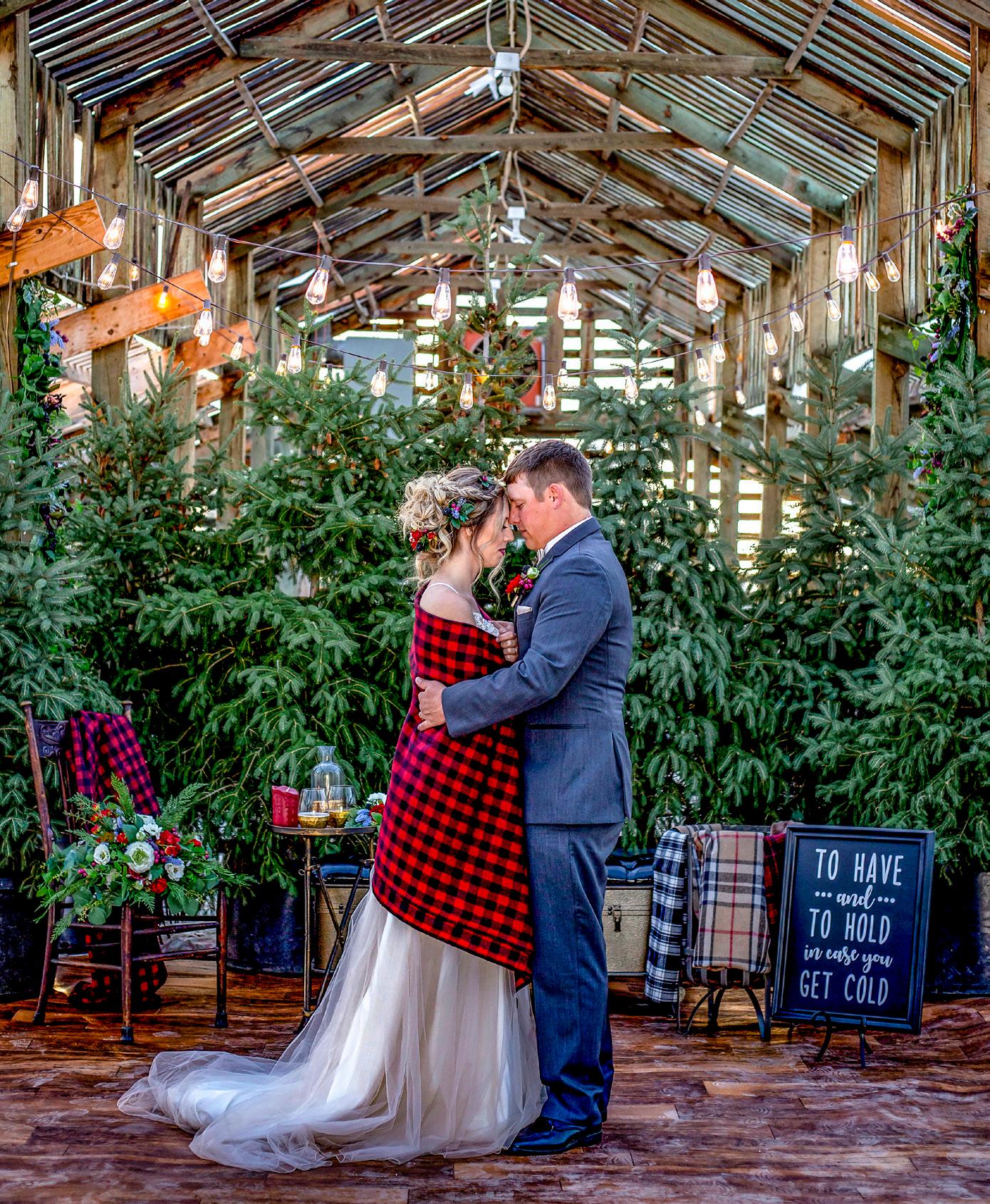
35 BETTY SHELDON + NESD HEAD START + STACY GOSSMAN + FATHER HAIRE FREE NOVEMBER/DECEMBER 2018 Holiday GIFT GUIDE FOR HIM, HER & THE KIDS P.30 Yuletide Bliss A Festive Winter Wedding P.36
18 IN PLEIN AIR Artist Betty Sheldon is using her retirement years to enjoy the scenery with a paintbrush in hand

20 WITH VOICES TOGETHER
The Aberdeen Area Community Choir is back at practice as they prepare for their second concert season

22 LIFELONG LEARNERS Teachers and staff at NESD Head Start are making preschool a possibility for low-income families

24 DOWN-HOME AND HOMEMADE
Comfort food is king at Big Fella’s and Scotty’s. Meet the owner behind the grill at both Aberdeen restaurants

26 DO UNTO OTHERS
Pat’s Golden Rule approach to navigating the holidays
30 THAT’S A WRAP
Holiday gifts for everyone on your list. Bonus: You can find them all right here in Aberdeen
40 WORKING ON THE CHAIN GANG
A few home team fans have a special role, and a front-row seat, at every football game

32 HUMANITY'S FRIEND
Aberdeen’s first Catholic priest was not only a trailblazer in his faith, but also fearless in standing up for the important issues he believed in
36 THE ROMANCE OF WINTER
Weddings aren’t just for spring. See how beautiful walking down the aisle in winter can be
ON THE COVER
44 THE GHOST TOWNS OF BROWN COUNTY Drought, the Dirty Thirties, and unpredictable changes in the rail line spelled disaster for some early Brown County settlements
Photographer Christina Shilman partnered with Beadle Floral & Landscaping to create the mock winter wedding scene shown on our cover featuring couple Kyle and Dakota Murphy. Weddings in blustery South Dakota are most often held in the spring and summer months. But this photo, with its deep green hues and warm plaid blankets, invites us to embrace the softer, more elegant side of winter, making it a season worthy in its own way of special celebrations like weddings.

REGULARS
HUB Your source for what’s happening in Aberdeen
CHEER
school year with a full lunchbox thanks to Veda and Elsie’s Lunchbox Drive
an event in the Hub City
04 FROM THE EDITOR 06 THE
12 FILLED WITH
Hundreds of Aberdeen students started their
14 CALENDAR Never miss
16 125 YEARS YOUNG
VOLUME 6 ISSUE 6 ABERDEENMAG.COM
FEATURES
The Hub City brand produced for Regal celebrated their 125th birthday with an open house and facility tour
November/December 2018
BETTY SHELDON NESD HEAD START STACY GOSSMAN FATHER HAIRE Holiday GIFT GUIDE Yuletide Bliss A Festive Winter Wedding
Photos by Troy McQuillen
18 22 20 24 40 2
ISSN 2378-3060
Putting together Aberdeen Magazine always feels a bit like organizing a large family photo. All of the people and stories we feature are praiseworthy on their own. But when we group them together into this tangible thing that we can flip through, it’s almost as if we get to zoom in on a small piece of our wider community portrait.
For our last issue of 2018, we’re pulling topics from all genres. Sports. History. Food. Shopping. Art. A Wedding. On these pages you’ll find all of the above, plus more. Page 40 is a behind-the-scenes glimpse of Aberdeen’s longstanding “chain gangs.” (It’s not the group of convicts that first comes to mind. Hint: You’ll find these guys beside the field at every home football game.) We’ll also get to meet plein air artist Betty Sheldon (page 18), the owner of two Aberdeen eateries (page 24), a few of the faces making a difference at NESD Head Start (page 22), and some of the talent at the Aberdeen Area Community Choir (page 20).
Lately we’ve heard from quite a few readers who’ve let us know how much they enjoy our history pieces (we love them too!). So before we look ahead to the new year, we’re taking a moment to look back at the life and humanitarian acts of Aberdeen’s first Catholic priest, Father Robert Haire (page 32). We’ll also spend time in some of Brown County’s early settlements that didn’t make it through tough economic circumstances like the Dirty Thirties (page 44).
Of course we wouldn’t give you a November/December issue without first adding a little holiday flair. Photographer Christina Shilman and Beadle Floral & Landscaping teamed up to bring you a rustic winter wedding, found on page 36. And if you’re like me and need some inspiration to get into the shopping spirit, our local holiday gift giving guide on page 30 might be just the thing you need to finish (or start) checking items off your list.
Last but not least, whether you’re into setting New Year’s resolutions or not, “Do Unto Others” on page 28 has some practical (and golden) guidelines we can all adhere to when we’re out and about.
Whatever your place in the big picture of Aberdeen, we hope you have a holiday season that is both very merry and bright.
MIKE MCCAFFERTY is an avid historian, accomplished writer, professional fisherman, and trainer. His passion is Great Plains history, and he currently serves as a member of the Dacotah Prairie Museum Board. Mike has had over 200 articles printed in outdoor magazines throughout the Midwest and Canada.


MANAGING EDITOR
Jenny Roth

PUBLISHER
Troy McQuillen

DESIGN
Eliot Lucas
AD SALES
Abby McQuillen
abby@mcquillencreative.com
PUBLICATION OFFICE
McQuillen Creative Group 423 S. Main St., Suite 1 Aberdeen SD, 57401 (605) 226-3481
PRINTING
Midstates Printing
SUBMISSIONS
Aberdeen Magazine welcomes your input. Message us your story ideas, drop off historic photos, or stop in for a chat. Email us at: troy@mcquillencreative.com
WEBSITE www.aberdeenmag.com
PRIVACY STATEMENT
Any personal information, email addresses, or contact submitted to the editorial office or online via our Facebook page will not be sold or distributed. Aberdeen Magazine does wish to publish public comments and attitudes regarding Aberdeen, therefore written submissions and comments on our Facebook page implies permission to utilize said information in editorial content.
CHRISTINA SHILMAN is a wife, mom to an amazing baby boy, mental health therapist, and owner of Paisley Tree Photography. Her photography business opened in 2013, and specializes in weddings, seniors, families, children, and lifestyle sessions. She loves capturing authentic and unforgettable moments for her clients.

PUBLISHER'S NOTE
KYLE AND DAKOTA MURPHY were our models for our winter wedding photo shoot. The Murphys were married in July 2017 at the place where they first met, Rolling Hills Golf Club in Aberdeen. Together they enjoy playing golf and spending time with their bernedoodle pup, Finley.

Our previous issue was our biggest one to date, featuring more stories and more support from advertisers. This was due in part to our summer intern from Texas, Erica Campbell. Erica just began her third year at the University of Texas Austin where she is pursuing a degree in advertising. She spent the summer in Aberdeen visiting her mother, working at Anchors Away, and helping us with ad sales. From all of us, thanks so much Erica!
Aberdeen Magazine is produced exclusively in Aberdeen, South Dakota. All content is copyright with all rights reserved. No content may be shared, copied, scanned, or posted online without permission. Please just ask us first. We’re pretty flexible.
www.mcquillencreative.com
Jenny Roth, MANAGING EDITOR
FROM THE
EDITOR
PATRICK GALLAGHER is a regular contributor commenting on Aberdeen’s personality, food options, and history.
VOLUME 6 • ISSUE 6 • NOV/DEC 2018
THIS ISSUE ’ S
CONTRIBUTORS
4 ABERDEEN MAGAZINE november/december 2018
THE hub
JOIN THE TABLE
THE FUTURE LOOKS ‘PAW’SITIVE
After serving pets at their current location for close to 40 years, the Aberdeen Area Humane Society is getting ready to construct a new facility. Annie Stenvig, a member of the humane society’s board of directors, says the building project will not only give the shelter a greater capacity, but also provide more opportunities for it to be a service in the community. “There’s a lot of good things that will come from a more modern facility, including a better layout. We’ll be able to safely quarantine neglect cases that come in, as well as make it better for the animals while they’re here. We also hope to add a kind of education center that does things like allow kids to come in and read to pets, and to include an improved visitation room.” Currently, they are looking at different building plans for the structure, which will be located just north of the existing shelter southwest of Aberdeen. Annie estimates that it will be about a five-year project from start to finish.
The Aberdeen Area Humane Society provides rescue and shelter for pets throughout northcentral and northeast South Dakota and southeast North Dakota. They run entirely on donations from Brown County and the surrounding communities. // — Jenny Roth For information on how to help the shelter and give specifically to their building fund, call 605-226-1200 or check out www.anewleashonlife.net.

You don’t have to be a highlevel executive to take your seat at the Executive Roundtable. The networking group, which meets monthly over lunch at the Smart Center, is open to professionals in all fields, whether you manage a large company with hundreds of employees, or operate a small business with less than a handful of people on your payroll. Member Mike Bockorny explains that the purpose of the Roundtable is to gather professionals who want to pool their resources, learn, and problem solve collaboratively. “It’s amazing that no matter what line of work you are in, the challenges we all face are very similar. The greatest benefit of the Roundtable is that we all get in the same room and share ideas back and forth to work on solutions together instead of separately, so we’re all better in the long run.”
The Executive Roundtable is member driven, meaning the current 15 members pick which topics are covered during each meeting through speakers, presentations, and group discussions. Joining costs $250 per year, and includes a spot at the table and lunch every month.
New members are welcome and encouraged to contact Mike Bockorny at 605-229-5335 or mikebockorny@adcsd.com with questions. // — Jenny Roth
YOUR SOURCE FOR WHAT’S HAPPENING IN ABERDEEN
Photo by Troy McQuillen
6 ABERDEEN MAGAZINE november/december 2018
The Aberdeen Area Humane Society recently unveiled plans to build a new shelter.
STREET STYLE
We all love food, and healthy, conscious eating has been steadily gaining more and more attention. To add to Aberdeen’s food scene, Natural Abundance recently decided to take their products beyond the walls of their store by opening a food truck. The rig is managed by the cooperative’s co-manager, Amy Crawford. She says patrons can expect to see a simple menu with juices, smoothies, sandwiches, and soups. All of their selections will be made from food that is raised organically on local farms, and their menu will adapt depending on which ingredients are in season. If all goes as planned, the food truck kitchen will keep cooking during the fall and winter months, serving grab-and-go items available for pick up at Natural Abundance and during special events around town. But this endeavor is just one of the ways in which the cooperative is expanding their reach. Late this summer, they also took over management of the Aberdeen Farmer’s Market, as well as obtained a beer license that they’ll use to make small-batch craft beers in store. // —
Jenny Roth
For more details on the food truck’s hours of operation and other happenings, visit the Natural Abundance Facebook page.
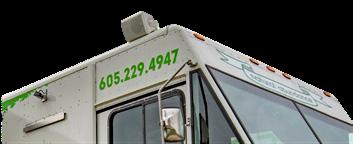
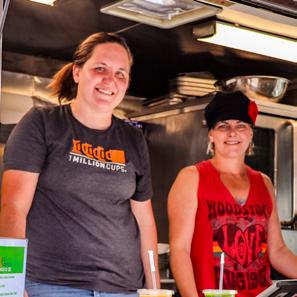

A FRESH START
This September, Colorful Creations celebrated the grand reopening of their new studio in downtown Aberdeen. The space, located at 207 S. Main Street, has the same opportunities for pottery and canvas painting, board art, events, and classes, but with the added bonus of more square footage and room to create. They’ve also incorporated handmade gifts fashioned by South Dakota artists and a children’s storytime painting party package to their lineup.
Owner Carly Pochop says their building was established in 1912, and that part of the excitement of opening their new location has been remodeling the structure to bring the arts downtown. She adds that the studio offers something for all ages. “We promise you’ll feel welcomed and ready to let your creative juices flow.” // — Jenny Roth

To learn more about Colorful Creations, go to www.thecolorfulcreations.com
TRANSPORTATION MODERNIZATION
Meet the 2018 Pierce Velocity™ 107’ Ascendant®, also known as the latest fire truck to join the Aberdeen Fire and Rescue Team. The truck is valued at over $900,000, and besides its good looks, it also comes with innovative features such as a 8KW Harrison Generator, a water tank capacity of up to 500 gallons, and a heavy-duty, steel aerial ladder with a vertical reach of 107 feet. // — Jenny Roth

BUZZ
Natural Abundance is serving seasonal dishes from the kitchen of their food truck. Pictured are the co-op’s co-manager, Amy Crawford (left) and general manager, Kristie Harger.
Photos by Troy McQuillen
Carly Pochop has expanded her Colorful Creations Art Studio by moving to a bigger location in downtown Aberdeen.
8 ABERDEEN MAGAZINE november/december 2018
The Aberdeen Fire and Rescue Department’s has a new set of wheels.
STRETCHING TO NEW HEIGHTS
Aberdeen yogis are taking their practice off the mat and into the air. After months of planning, Profiling Beauty Health and Wellness Center has opened their new aerial yoga studio. Owner Candace Briscoe says she received her certification to be an aerial yoga teacher years ago, and has been dreaming of bringing this form of yoga to Aberdeen ever since. In September, she hosted an open house and revealed the finished studio to the public. The space includes a dozen yoga trapeze swings for participants, and eight instructors have been trained to lead classes. Along with installing the aerial equipment, Candace added details like red therapy lights and a wall adorned in a chalk paint mural. While the thought of hanging from the ceiling might seem daunting, Candace explains that aerial yoga is for all ages and abilities and can provide benefits for the neck, lower back, and hips. By taking out gravity, you can get a deeper stretch in your favorite yoga poses. To top it off, classes end with everyone relaxing hammock-style in their trapeze while instructors provide massage techniques. // — Jenny Roth
The aerial yoga studio is located in the lower level of Profiling Beauty, at 224 1st Ave SE. For more information on how to sign up for a class, head to www.leanbodybarre.com

BABY FEVER

Jordyn Volk of Jordyn Photography and Aleece Jung of Luna Birth Services are teaming up to host the inaugural Hub City Baby Expo, happening November 11 from 11:00 AM to 4:00 PM at the Dakota Event Center. Presenters from across the state will be at the expo providing education for new and expecting parents, those who are planning a family soon, and experienced parents. Topics will cover things like safe car seat installation, preparing your finances for a new addition, and prenatal and postpartum care
SHE'S GOT SOLE
Whether you have aching feet, or not, Amber Hanson of Heart and Sole Foot Zone Therapy invites you to kick off your shoes and take some time for yourself with a foot zone session. Amber is a licensed practical nurse and foot zone practitioner. She recently moved her home-based foot zoning business to 415 S. Main Street, Suite 303, located just above the Capitol Theatre. Along with providing foot zone sessions for clients, she’ll also host foot zone certification and 1-2-3 classes at her new space.

To better understand what foot zoning is, Amber explains that if our bodies are computers, then our feet are the keyboards. During a typical foot zone session, most of which last about an hour, she will access different signals on the top, sides, and bottom of the feet. Triggering these signals can reach all parts of the body, promoting overall health and a chance for us to “reboot” to our natural state of wellness. She adds that foot zoning can help with things like rejuvenating the immune system, improving sleep, aiding in digestion, and faster recovery from injury or illness, but that you don’t have to have a specific ailment to schedule a session. “Health is a multifaceted thing. Being able to come here and sit and put your feet up for an hour, there’s so many benefits to that in addition to the foot zoning technique.” // — Jenny Roth
To learn more about Heart and Sole Foot Zone Therapy, call 605-622-0182 or go to www.heartandsolefzt.com
for moms. Along with the presenters, an estimated 30 vendors will be on site. Jordyn and Aleece say the goal of the expo is to help families connect with area resources that can help them navigate pregnancy, birth, postpartum, and parenting. // — Jenny Roth
More information is available at www.facebook.com/ hubcitybabyexpo/.
BUZZ
Aberdeen’s first aerial yoga studio is at Profiling Beauty Health and Wellness Center.
Photo by Jordyn Photography
The Hub City Baby Expo promises to be a valuable resource for new and experienced parents.
10 ABERDEEN MAGAZINE november/december 2018
Amber Hanson has opened a relaxing foot zone therapy oasis on Main Street. Photo by Troy McQuillen
FILLED WITH CHEER
Veda and Elsie’s Lunchbox Drive spreads joy to local students
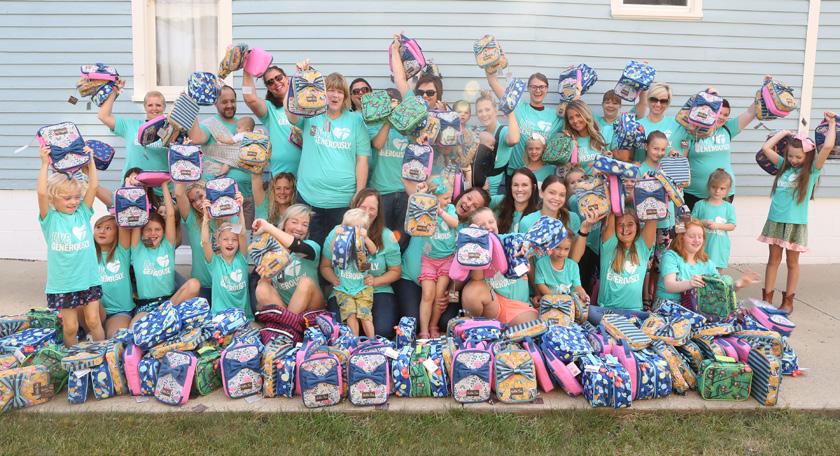



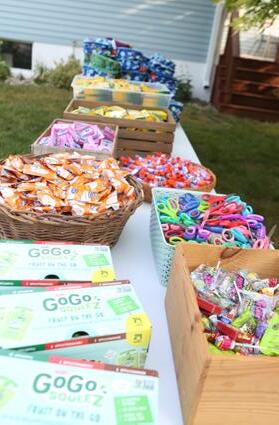

 by JENNY ROTH
by JENNY ROTH
Amber Bergeson and her daughters, Veda and Elsie, are showing that it only takes a small act of kindness to brighten someone else’s day. This year the trio hosted their third annual Veda and Elsie’s Lunchbox Drive, a fundraiser that gives lunchboxes filled with snacks and school supplies to young students in Aberdeen. With the help of over 40 volunteers, they were able to assemble 250 boxes with all kinds of goodies- from crayons and scissors to goldfish crackers and fruit snacks- on a single Saturday in August. After the boxes were compiled, Amber, Veda, and Elsie then delivered them to all the second graders at both Lincoln and Mike Miller Elementary, the Child Protection Team, the Boys and Girls Club, and counselors at other elementary schools to distribute at their discretion.
In 2015, Amber became a trunk keeper for Matilda Jane, a women’s and girl’s clothing company. She saw how much her daughter Veda adored carrying her floral Matilda Jane lunchbox, and it gave her the idea to spread that excitement to other children by giving them “something new, beautiful, and something they could keep.” That fall, she put out a request on Facebook asking sponsors to donate $25 toward a lunchbox that she would fill using the money earned from her commission. Her goal for that first drive was 25 boxes, but they ended up with enough sponsors for 60. The following fall, the fundraiser grew to 160 boxes, and this year was their largest yet. Amber says, “In the future, I’d love to see the project grow enough to give lunchboxes to all second graders city wide. Next year, 300 boxes!” //
To sponsor a lunchbox or help with Veda and Elsie’s Lunchbox Drive for 2019, email amberbergeson@ matildajaneclothing.com.
SCENE
Photos by Amber Bergeson
Over 40 volunteers filled 250 lunchboxes with school snacks and supplies. 12 ABERDEEN MAGAZINE november/december 2018
Veda Bergeson helps fill lunchboxes.
NOVEMBER & DECEMBER
ABERDEEN UNIVERSITY/ CIVIC SYMPHONY

November 3, 7:30 PM
JFAC and Harvey and Cynthia Jewett Theater, NSU
Adults $18, Students Free
The Aberdeen University/Civic Symphony begins their 2018-2019 season with an opening concert at NSU. Conductor Christopher Stanichar will lead an ensemble featuring Sonja Bundy, principal violin of the Sioux City Symphony.
PHEASANT SANDWICH SHOOTOUT
November 8, 6:45 PM
Aberdeen Civic Arena
Free Admission
Experience a bit of Aberdeen’s past, and present, at the Second Annual Pheasant Sandwich Shootout. Professional and home chefs will compete for cash (and bragging rights!) as we see who makes the best modern-day version of the pheasant sandwich.

BRIDAL SHOWCASE
November 4, 12:00 PM - 3:00 PM
Dakota Event Center
Free Admission
If wedding bells are in your future, Aberdeen’s 8th Annual Bridal Showcase is where you want to go to get inspiration for your big day. Meet with wedding industry professionals who can help you find photographers, cakes, invitations, decor, bridal fashion, and more.
WINTERFEST
November 17, 9:00 AM - 5:00 PM
Aberdeen Civic Arena
Free Admission
The weekend before Thanksgiving is set aside for art, food, and entertainment at Aberdeen’s Winterfest. Nearly 50 artisan booths make up this fine arts gallery shopping experience that promises to have one-of-a-kind gift items you can’t find in stores.

PC ARTIST LECTURE SERIES: JAMES POLLOCK
November 14, 1:15 PM - 3:30 PM
Lantern Hall, PC Campus Free Admission
James Pollock was one of 46 artists sent to Vietnam by the U.S. Army as part of the Vietnam Combat Artist Program. His presentation will include a historical overview of this program and examples of the paintings and sketches made by the soldier artists involved.
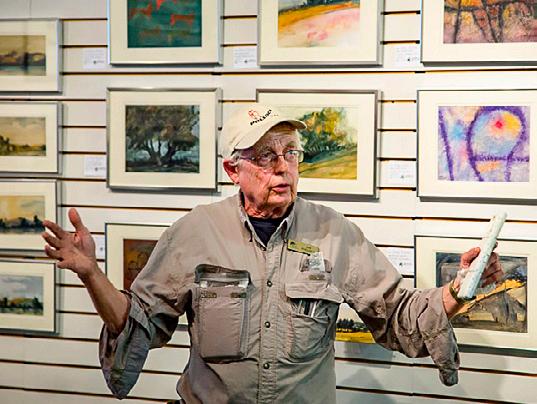
MOSCOW BALLET’S GREAT RUSSIAN NUTCRACKER
November 26, 7:00 PM -9:00 PM
NSU
Tickets start at $28
A timeless Christmas story takes the stage during the Moscow Ballet’s Nutcracker. Watch for young dancers from the Aberdeen area who practice with the ballet throughout the fall and are part of the performance.

HOLIDAY CELEBRATION FOR YOUTH
December 10, 6:30 PM - 8:30 PM
Aberdeen Civic Arena
$1 Per Person
Children and their families are invited to spend the evening playing games, making crafts, singing songs, and having fun at this holiday party hosted by Aberdeen Parks & Rec with help from Dacotah Prairie Museum, and the Girl Scouts.
INTERNATIONAL SAXOPHONE QUINTET
November 19, 7:00 PM
NSU’s Harvey & Cynthia Jewett Theater
Adults $35, Students $10
Five Sax, hosted by the Aberdeen Community Concert Association, brings you an evening filled with live music as performed by a modern-style saxophone quintet. The group combines theatrical elements with their classical, jazz, South American Latin, and European folk music.
BIGGEST NEW YEAR PARTY IN TOWN
December 31, 9:00 PM - 2:00 AM
Fraternal Order of Eagles
Ring in the new year with a black and gold theme party at the Eagles, featuring live music by the Union Cattle Band, free champagne at midnight, and prize giveaways throughout the evening.
ABERDEEN LIVING
CHRISTMAS TREE
December 1, 7:00 PM &
December 2, 3:00 PM & 7:00 PM
Aberdeen Civic Arena
Free Will Donation
Christmas trees come alive with music at this event that has signaled the start of December in Aberdeen since 1988. The Living Christmas Tree includes orchestra, adult choir, and children’s choir performances.

CALENDAR
14
125 YEARS YOUNG
Regal celebrates a noteworthy Hub City milestone
 by JENNY ROTH
by JENNY ROTH
What started as a blacksmith shop next to the railroad tracks has grown into a global brand for transmission products that reaches industries across the board.
The Hub City brand produced in Aberdeen for Regal Beloit Corporation first opened for business in 1892. Since then, Hub City has played an active role in both the history of Aberdeen and the world.
During the first and second World Wars, Hub City Inc. evolved into manufacturing to build components for the war efforts. For locals, many may remember the fire that later destroyed their three-story brick building in downtown Aberdeen in the 1970s. Remarkably, no one lost their life, or a paycheck, in the incident and they reopened at their current location on Industrial Avenue just one year later.
Today, the Hub City brand of gearboxes and speed reducers is a part of almost every aspect of consumer life, from those on the refrigeration trucks that carry food across the country, to the ones made for pumps that operate clean water wells in Africa. The Aberdeen operation’s niche is that half of what they manufacture is either custom or modified products. Their engineers help customers in just about any industry to design items that meet their specific needs, whether that’s a gearbox that can fit into your pocket or one that weighs 10,000 pounds, and everything in between.
To commemorate their 125th year in business, in August Regal invited employees and their families, along with the public, to tour their Aberdeen facilities for an afternoon. On the tour, guests were able to view Hub City products and learn how they reach people on all parts of the globe. //

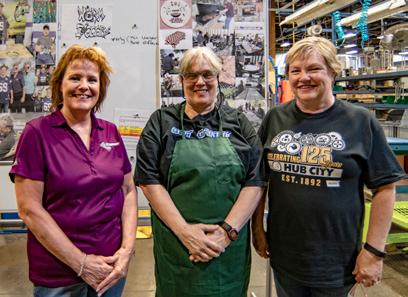
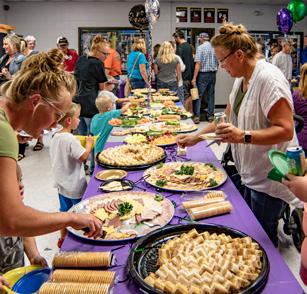


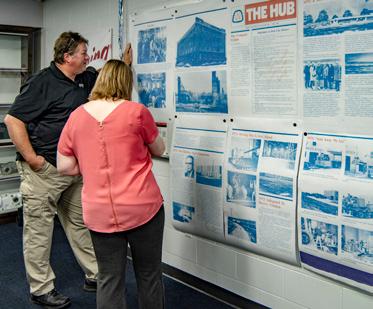
SCENE
Photos by Troy McQuillen
A group of retirees gathered for the Hub City brand's anniversary.
Dignitaries present a proclamation to management staff.
Regal employees Susan Holtey, Nancy Backous, and Cheryl Grant.
16 ABERDEEN MAGAZINE november/december 2018
The VIP tour at Regal's Aberdeen location.
IN PLEIN AIR
by JENNY ROTH
Among all the things that make up our busy lives, finding even an extra hour or two to spend on a creative passion can seem impossible. Local artist Betty Sheldon knows what this is like. She says she has always wanted to paint, but just couldn’t carve out the time to do so until she was in her 50s. Later in her retirement years, she found herself reorganizing her schedule and making a list of the things she wanted to do. Painting was at the top of that list. Since then, she has dedicated a good portion of her days to finding out what she can really do with her art. Her encouragement to others who want to do the same is straightforward. “Take whatever it is that catches your interest and just start.” She adds, “All of us struggle to find that time and give it a priority, it’s not easy, but in whatever kind of art you’re doing practice and repetition are very important. If you can do a little bit every day, that’s fabulous. Carry it with you. If you’re going to draw, keep a small pad and pencil in your car or purse or pocket and take it out while you’re waiting for an appointment or at a ball game.”

For Betty, a milestone in her journey as an artist happened on a train ride when she gathered the courage to paint in a very public place for the first time. While on an Amtrak to Washington, D.C., she opened her sketchbook in the vistadome car and started to sketch the scenes around her, onlookers watching and all. She continued to paint and sketch the sights during that trip, and has taken the practice of painting in the outdoors versus in the studio, called
plein air painting, with her ever since. Thanks to her traveling watercolor and oil kits, she has been able to capture many beautiful landscapes and “urban art” scenes. Remembering a time that she and her brother, who is also an artist, painted some old buildings in a small town shortly before they were torn down, she says, “One thing I love about plein air painting is that it puts me right back to where I was when I did that painting.” Another example of this is evident in one her paintings of Mina Lake where the waves lap at the shore and the trees all bend to one side. She looks back on that day as one of her more challenging moments of painting in the South Dakota outdoors. “The wind must’ve been blowing 40 mph. I worked so fast and had to literally hold everything down.”
Another reason Betty adores plein air painting is because of the people she has met while doing this form of art. She explains, “Painting on the streets or at a plein air event is almost like performance art, which I don’t enjoy particularly, but I do strongly feel that people, especially children, should see adults doing art.”
Thinking of her own childhood, she doesn’t recall seeing grown-ups painting or drawing, and it didn’t occur to her that
it was something she could take into her own adulthood. “I think it has an affect on a child, whether they want to do art or not, to know that it is something people do,” and she adds with a laugh, “and that you can do it in public!”
Betty has learned to paint mostly by practicing and from taking a few classes and workshops here and there. Along with watercolors and oils, she recently began making still lifes and portraits with pastels. Her work is available for commission and has appeared in numerous exhibits, but she says when she started out that running a business was never her intention. She encourages other artists who have plans to make a living with their art that doing so is possible. “If you’re in school studying different techniques and forms, it’s equally important to learn some business and entrepreneurship skills to compliment those.” It also helps to surround yourself with others who value creativity. A year ago, Betty formed a casual art group of about 25 people who get together, have a potluck, and share a project that they want to talk about. “Everyone seems to leave with new inspiration,” she says.
So what comes next for an artist who is growing in her own skills while also bolstering a creative community? According to Betty, she still has more to do. “I have a lot of aspirations, and I hope I can keep my energy up to do them. I was planning on living to 100, but people are living longer now, so I’m planning on 110.” //
GALLERY
Artist
Betty Sheldon inspires others to live their best creative life
“…I do strongly feel that people, especially children, should see adults doing art.”
Photo by Troy McQuillen
18 ABERDEEN MAGAZINE november/december 2018
Artist Betty Sheldon paints an outdoor scene at the Granary Rural Cultural Center Plein Air Art Event in September.
LOCAL ART GALLERIES
WEIN GALLERY
Presentation College
1500 North Main Street 605-229-8350
Mon-Fri 8 AM-5 PM
PRESIDENT’S GALLERY, JFAC
GALLERY AND STUDENT CENTER
GALLERY
Northern State University 1200 South Jay Street 605-626-7766
President’s Gallery: Mon-Fri 8 AM-10 PM, JFAC Gallery: Mon-Fri 8 AM-4:30 PM, Student Center: Mon-Fri 7 AM-11 PM and weekends 1-9 PM
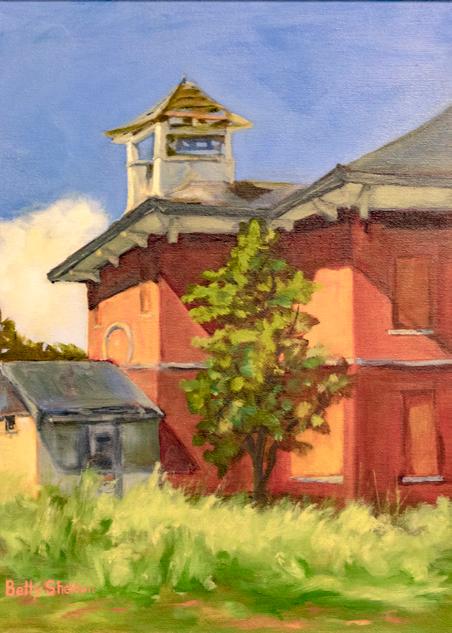
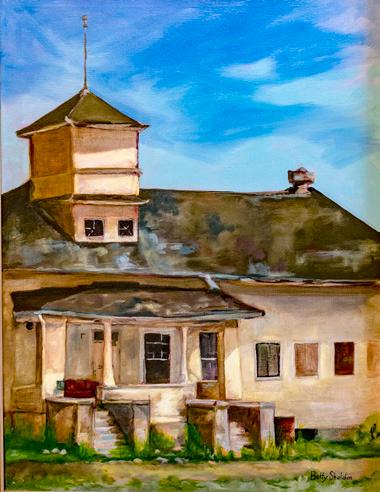
LAMONT GALLERY


Dacotah Prairie Museum
21 South Main Street 605-626-7117
Tues-Fri 9 AM-5 PM, Sat and Sun 1-4 PM
ARTWORKS CO-OP GALLERY
Aberdeen Mall
3315 6th Ave SE Suite #48 605-725-0913
Thurs-Sun 12-6 PM or by appointment
JANE WEST GALLERY
Capitol Theatre 415 South Main Street 605-225-2228
Open during events, call ahead for additional hours of operation
ARCC GALLERY
Aberdeen Recreation and Cultural Center 225 3rd Ave SE 605-626-7081
Mon-Thurs 9 AM-8 PM, Fri 9 AM-5 PM and Sat 10 AM-12 PM
RED ROOSTER COFFEE HOUSE
GALLERY 218 South Main Street 605-225-6603

Mon-Thurs 7 AM-9 PM, Fri 7 AM-11 PM and Sat 8 AM-11 PM
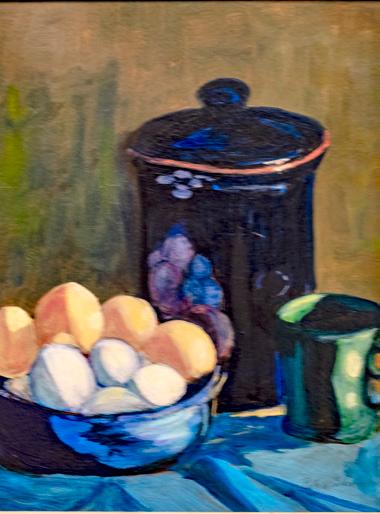 In Mahto to Wakpala Betty painted a landscape from a side road north of Highway 12 on the Standing Rock Reservation.
In Mahto to Wakpala Betty painted a landscape from a side road north of Highway 12 on the Standing Rock Reservation.
november/december 2018 ABERDEEN MAGAZINE 19
An old, red schoolhouse fills the canvas in Betty’s School Vacation.
WITH VOICES TOGETHER
how tunes? Operatics?
Musical theater? Piano? Recorder? Quartets? Soloists? The Aberdeen Area Community Choir has them all. For Richard Wilson, the group’s music director, it doesn’t matter if you think your voice isn’t good enough. More than talent, what he says is most important is a willingness to practice, and have some fun while working toward performance nights. “It’s open. I take all comers. The choir’s for anybody that has any kind of instrumental or vocal performance desire or music skill at least through high school or maybe into college a little bit.”

To successfully organize a community choir that practices weekly all year long, except for a break during the summer months, you need to have both skill and enthusiasm for what you do. Richard has both. A music instructor for nearly 30 years, he says he has always been involved in musical theater in some capacity. Currently, he teaches music at Lincoln Elementary and also sings with the Aberdeen Men’s Chorus and Living Christmas Tree. Before directing the Aberdeen Area Community Choir, he learned how to form regularly performing choirs in other communities through his mentor and friend Weston Noble, the music department founder at
Luther College in Decorah, Iowa.
Richard’s voice lights up when he talks about his Aberdeen area choir. The group is just starting its second season, and his favorite part about their inaugural year is going back and listening to their recordings. “We’re not professionals, I have people who like to sing and that’s what I want. In rehearsal I’m focused on trying to do things with the group, but in the end when I go back and listen to the recordings I think, ‘They sound pretty darn good!’” The choir is made up of all kinds of singers, from students to snowbirds, who get together to rehearse every Sunday evening at Plymouth Congregational UCC on Melgaard Road. They’re genres range from songs that are 500 years old and in Latin to modern music. Richard adds, “It’s the least musically restrictive environment that I can create.”
Last year the choir of nearly 30 vocalists performed two concerts, one in the winter and one in the spring, along with sending some members to sing with the NSU Chorus. This season, Richard hopes to have closer to 40 participants. Instead of a winter concert, they’re opting for caroling at elderly care facilities around town during the holidays, and they’re keeping their spring concert while also adding a Choir Festival to the roster. The festival, happening April 7 at NSU, is a fundraiser for Safe Harbor where several community choirs will come together to perform their own pieces and a bass choir finale, directed by NSU’s choral director, Dr. Timothy Woods.
When asked about his plans for the Aberdeen Area Community Choir’s future, Richard says he hopes the group continues and thrives for years to come. The choir is not only a creative outlet for its members, but also an opportunity to make friends and try something new. They’re even looking into the possibility of traveling to Aberdeen, Scotland, someday and performing with community choirs from that region. And while their 2018-2019 season is already underway, Richard welcomes anyone interested in joining to come check out one of their rehearsals to see what they’re all about. “I run a tight ship when we perform, but we have a lot of fun getting there. Otherwise, what’s the point?” //
UP CLOSE
To learn more about the Aberdeen Area Community Choir, visit www.aberdeenacc.com or email aberdeenareacommunitychoir@gmail.com.
As they rehearse for their second concert season, Richard Wilson takes us behind the scenes with the Aberdeen Area Community Choir
by JENNY ROTH
S
Music director Richard Wilson (seated at piano) leads the Aberdeen Area Community Choir as they gather for their weekly Sunday evening rehearsal.
20 ABERDEEN MAGAZINE november/december 2018
Photo by Troy McQuillen
LIFELONG LEARNERS
 JENNY ROTH
JENNY ROTH
It’s a typical weekday morning at the Aberdeen Head Start Center. The three classrooms in the building are humming with activity as teachers and assistants share math, language, and other early childhood education skills with their preschoolers. About 34 students come to learn and play in each of these classrooms every day. Half are here for morning classes, while the other half will attend the afternoon session.
Meanwhile, the staff in the Head Start kitchen have cleaned up breakfast and are busy preparing lunch for over 100 three, four, and five-year-olds, followed by a snack later on. Family service workers are assisting the students’ families and organizing the next parent-child field trip. Down the hall, the human resources department, which also happens to be the IT and transportation department,
is running the cars, buses, computer network, and employee payroll at any given moment. Managers and coordinators are present everywhere, pitching in to help wherever they’re needed.
If this sounds like a well-intentioned facility, that’s because it is. But it doesn’t just operate on planning and schedules alone. All of the people who work here put in those extra small acts of effort and kindness that often times make the biggest impact. For example, no matter what position you have, everyone at Head Start is willing to take a moment and pick the weeds on the playground. And it isn’t uncommon for family service workers to drive parents to important appointments when they need a ride. On the day I visited the school, the education coordinator passed me multiple times with a wrench or other tool in hand, fixing and installing things in the building. And that human resources-IT-
transportation department we talked about, that’s a one-man department checking off all those tasks. I also witnessed staff carefully setting up cubbies and putting labels on toothbrushes for each student so the children can easily find their things, and feel more at home too.

Head Start is a federal program that exists nationwide to provide preschool at no cost to low-income families. There are 10 Head Start programs in South Dakota alone. The Northeast South Dakota Head Start Program, whose headquarters are in Aberdeen along with the Aberdeen preschool, covers 13 counties, 1,500 square miles, and serves about 380 children through centers and home visits. Along with early childhood education, Head Start offers family, health, and nutritional services. NESD Head Start executive director, Juli Schultz, sums up Head Start well by explaining that while their focus is on

UP CLOSE
NESD Head Start goes above and beyond so students can realize their full potential by
Photos by Troy McQuillen
The staff at NESD Head Start in Aberdeen are back row, l to r: Julie Grote, Jessica Lux, Krystina Hauck, Jon Meidinger, Davin Johnson. Seated l to r: Carol Rice, Cassie Freeman, Juli Schultz, Tawny Poirier, Amy Moore, Kristie Fliehs, JaNette Walden. Not pictured are Mary McDermott, Laura Beth Gatzke and LuAnn Myhre.
Brandy Cartney studies with one of her students, Jaydon McGhee
22 ABERDEEN MAGAZINE november/december 2018
Kasey Schaefer helps preschool students prepare for kindergarten at NESD Head Start in Aberdeen.
education, they are much more than a preschool. “We look at the overall picture of every child, where they’re at developmentally and physically, so we can best help them in all capacities and make sure, as the saying goes, they get a ‘head start’ in life.”
Teachers, staff, and parents all play a role in making Head Start what it is for the students. The teachers have early childhood credentials, and they work together to share ideas and stay up to date on curriculum options.


Teacher Brandy Cartney says, “I did my student teaching for NSU at Head Start, then became a teacher assistant, and now a teacher. This is my 12th year with the program and I always look forward to it and absolutely love it.” Parents can volunteer in classrooms too, and the policy council includes parent representatives who meet monthly and are involved in hiring and decision-making processes.
This is Juli’s first year as an executive director. She says her job has been made easier because most of the people she works with have been with Head Start in some capacity for a long time, and that it is in all of their hearts to do everything they can for the students while they get them ready for kindergarten. “For the children that come here, we want them to just grow and be confident and comfortable for school. We focus on that school readiness so that they’re set and have the tools they need, and that families have the resources they need to be the best parents, so that they can have a good school experience.”
With 102 students, the Aberdeen Head Start Center is at full enrollment, but due to families moving, they do have spots become available throughout the year. Juli concludes, “We want people to know that we’re here, and that we’re an option for preschool for many that might not otherwise have that option.” //




To learn more about NESD Head Start, visit www.nesdhs.org , call 605-229-4506, or email jschultz@nesdhs.org.



• 305 S. Main Street • redeemable at both locations Home mortgage financing with great options. Ona Hughes Mortgage Loan Originator ona.hughes@usbank.com 605.226.4140 NMLS #: 1114399 Equal Housing Lender. Loan approval subject to credit approval and program guidelines. Interest rates and program terms are subject to change without notice. Some restrictions may apply. Mortgage and Home Equity products offered by U.S. Bank National Association. Member FDIC. ©2017 U.S. Bank 160036 11/17 ’ Sat urday, Dec. 8 1:00 t o 4:00 p. m. Christmas Tree Lane & Holiday Wreaths, Family Fun Activities, Refreshments, Live Music & A special visit from St. Nick! november/december 2018 ABERDEEN MAGAZINE 23
Teachers at NESD Head Start in Aberdeen are back row, l to r: Dawn Hopfinger, Cortney Wuestewald, Dawn Hieb, Ashley Woehl, Brenda Radtke, Brandy Cartney. Seated L to R: JaNette Walden, Kasey Schaefer, Anita Brewer. Not pictured is Jeanne Spellman.
Down-homeHomemade and

STACY GOSSMAN HAS AN APPETITE FOR SENDING GOOD FOOD OUT OF HIS KITCHEN AND ONTO YOUR PLATE.
 by JENNY ROTH
by JENNY ROTH
COME HUNGRY
It all started with a group of friends, a piece of poster paper, and lots of whiskey, vodka, and beer.
Many businesses begin from “the ground up,” but Stacy Gossman literally planned, sketched, and built his restaurant, Big Fella’s Bar and Grill. “With the help of five of my buddies, we sat down with paper and a ruler and designed the place. Then we did everything to construct it- the dirt work, excavating, even down to mounting all the equipment on the walls.” With that kind of effort invested into something, it’s no surprise Stacy is proud of the business he’s owned for the past 16 years. “I wouldn’t change Big Fella’s for the world,” he says. The restaurant’s building isn’t the only thing made from scratch. Since opening their doors in 2002, Big Fella’s has been known for making everything homemade, from salad dressings to in-house smoked ribs to their famous prime rib that they’ve perfected with an 11-hour cook time. True to its name, Big Fella’s also has some menu items with epic portions. If you come hungry, you might try and devour the Big Fella Burger, a 50 ounce meal counting the fries.
Along with dinner, Big Fella’s serves an experience. The kitchen is open, so customers can watch their steaks being

UP
CLOSE
24 ABERDEEN MAGAZINE november/december 2018
Photos by Troy McQuillen
hand cut and interact with the people preparing their food. Stacy says this setup makes a personable atmosphere because the kitchen is not hidden in the back, and on a slow night “one person can take your order, fill your drinks, and cook your food.”
Patrons can expect to be part of the jokes and behind-the-scenes kitchen banter, and even get some grief from the staff from time to time. “The grill is the TV at my place. If you’re sitting at the bar and facing the kitchen, you’ll see all eyes are glued to what’s happening at that grill,” Stacy says.
BRINGING BACK THE CLASSICS
Over thirty years ago Stacy was working at an Aberdeen staple, Scotty’s Drive Inn. When he was passed over for an assistant manager position he left, and didn’t think much about it until the restaurant, which had been renamed to Daddy’s Bar and Grill, was closing. On a whim, he says, “I made a phone call and bought the place without even going to look at it.” The first thing he did was change the name back to Scotty’s and bring the menu back to its originality, with a Big Fella’s twist of course. For their breakfasts, Scotty’s echoes Big Fella’s in that they make everything homemade, like their sausage gravy, caramel roles, and omelettes. Their Soprano Omelette, also known as “The
Killer,” is made with chicken breast, sausage, onions, peppers, sliced mozzarella cheese, and comes with a stick of gum. For lunch and dinner, Scotty’s is all about the American drive-in classics. Think burgers, shakes, pizza burgers, and chili cheese dogs. Stacy says they make their comfort food flavorful, not greasy. “I like to eat, and if it’s something that I know is good, it’s going on the menu.”
CUSTOMERS, FAMILY, AND FRIENDS
Stacy is quick to mention that he’s had a lot of help along the way from both dedicated employees and friends. Cooking is an art he picked up from a handful of mentors, the most notable being his mother. Operating a restaurant kitchen is a skill


he’s learned over time, and by observing other well-managed establishments in the area. He adds that while it might seem like owning a business means you don’t have to answer to anyone, that’s not necessarily true. “My customers are my boss. If you think of where Big Fella’s and Scotty’s are located in town, people have to drive past a lot of other places to eat first. So I need to put things on my menu that keep them licking their chops long enough to want to get here.”
Most days you can find Stacy behind the grill at Big Fella’s or Scotty’s, preparing everything from breakfast to dinner. He says he’s happy to be there. “Even if I won the lottery, I wouldn’t want to do anything else. I look forward to going into work every day.” //
Big Fella’s Bar and Grill, 5759 Highway 12 East, is open Tuesday through Saturday from 4:00 PM to 10:00 PM. Scotty’s Drive Inn, 719 N. Main Street, is open Monday through Saturday from 6:30 AM to 9:00 PM and Sunday from 8:00 AM to 1:00 PM.

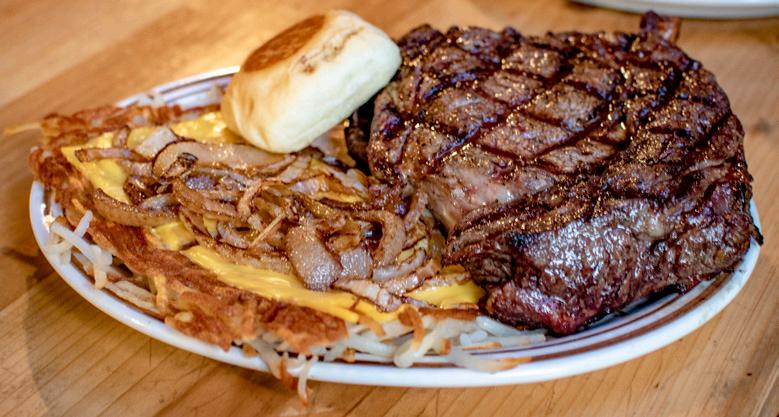
 Big Fella’s earns its name, serving dishes large enough for the heartiest of appetites.
The steaks at Big Fella’s are hand cut in house.
Big Fella’s earns its name, serving dishes large enough for the heartiest of appetites.
The steaks at Big Fella’s are hand cut in house.
november/december 2018 ABERDEEN MAGAZINE 25
The open kitchen at Big Fella’s lets customers order their food and watch it being prepared too.
UntoOthers
by PATRICK GALLAGHER
Several years ago, I was in Chicago on the Friday after Thanksgiving. The unseasonably warm, sunny day had brought out a lot of Black Friday shoppers. At one point, I found myself in a mob of pedestrians waiting at a red light to cross a street that intersected Michigan Avenue’s Magnificent Mile shopping district. A car was trying to cross Michigan but had gotten stuck in traffic. When it had inched about 80% through the intersection, the light turned red against him and green for us pedestrians. After a little hesitation on each side—driver and pedestrians—my horde took off, leaving the car stuck with its tail out in Michigan Avenue, blocking traffic and being serenaded with horns and helpful commentary and gestures. Somebody behind me said, “You snooze you lose, buddy.” Now there’s the holiday spirit! But it’s not only a city thing, however much we might wish (or believe) otherwise.
In the grander scheme of things, if we’d been watching this from, say, the top of the Sears Tower, we pedestrians might have realized we would have lost only a few seconds if we’d simply let the car through. But at ground level, we knew someone might have gotten in the Apple Store ahead of us! And we marched forward instead. Me included.
Reflecting on that scene has caused me to think about the guy in the car. Since we’re coming up on the season of snowdrifts, ice, and plow furrows—and we have all both benefited from and acted as Good Samaritans—it’s a good time to think about the Golden Rule (for a refresher: Do unto others as you would have others do unto you), as well as New Year’s resolutions. Here are mine:
NewPat'sYear's Resolutions notWhenIgoshoppingIresolvetoreplacemycartinthecartcorral,
linesWhenIparkmycarinaparkinglot,Iresolvetotrytofitbetweenthe ofasingleparkingspace.Asasub-resolution,I'lltrynottogetwillsoclosetooneoftheselinesthatneitherI,northeguynext
bangadoorintotheothercar,orhavetoreduce
leaveitintheparkingspacenexttowheremycarwas.Itwould lanebeeasierformetoleaveitthere,ortoletitrolloutintothedriving oftheparkinglot(that'swhythere'sacorral-tocontainthose justwildspirits).IwouldbefullywithinmyrightsasanAmericanto aboutleaveitwherever,because,afterall,ifthestorereallycared me(orthecart),they'dhiresomeonetocarrymystuffto biggerthecarforme.Butthat'snotwhatI'mgoingtodo;I'mgoingtobe thanthat.
Do
tofight
Parkingbyhalf,inordertogetintothevehicle. resolutionnumbertwo:resolveparkingspaces.Mycar
The holiday rush is on. But while you’re out checking items off your shopping list, don’t forget to slow down and follow the Golden Rule.
26 ABERDEEN MAGAZINE november/december 2018
Illustrations by Eliot Lucas
When I go shopping I resolve to replace my cart in the cart corral, not leave it in the parking space next to where my car was. It would be easier for me to leave it there, or to let it roll out into the driving lane of the parking lot (that’s why there’s a corral—to contain those wild spirits). I would be fully within my rights as an American to just leave it wherever, because, after all, if the store really cared about me (or the cart), they’d hire someone to carry my stuff to the car for me. But that’s not what I’m going to do; I’m going to be bigger than that.
When I check into a hotel—in Aberdeen (like for a kids’ birthday party or something—get your mind out of the gutter) or elsewhere—I resolve to return the luggage cart back to the lobby after I’m finished with it so that the next guest can use it, rather than having to come up to my floor to find it (most likely in front of a room a few doors away). Like stores and shopping carts, the hotels aren’t paying bell hops, but that doesn’t translate into entitlement for me to leave their property just anywhere. Well, maybe it does, but I’m not gonna.
When I park my car in a parking lot, I resolve to try to fit between the lines of a single parking space. As a subresolution, I’ll try not to get so close to one of these lines that neither I, nor the guy next to me, will bang a door into the other car, or have to reduce his chest size by half, in order to get into the vehicle.
Parking resolution number two: I will not park at an angle across two parking spaces. My car is just not that valuable. (And if you do that, I resolve to fight the all but irresistible temptation to park so you can’t get out of your space—although someone did that to me once, and my kids are still in awe that I got out of the space without inflicting or sustaining damage. Ah, reveling in the all-toofleeting moment: father as hero!)
When I’m driving [editor’s note: the driving topic could take a while—what’s the word count for this piece?], I resolve to use my turn signal when I intend to make a turn. I know that as a sovereign citizen, it would be my right to do whatever I want to protest the taxes I pay for the upkeep of roads and law enforcement, and other drivers should just be on their toes anyway and be prepared for whatever I decide to do. Maybe I’ll drive on the left side. It’s a free county!
Also when I’m driving, I resolve not to run a red light, even if it’s not my fault (although, really, how could it not be my fault?).
Last parking lot resolution: When I walk in the lot to or from the store, I resolve to follow the shortest, straightest line between two points and walk to one side or the other of the driving lane. While I have as much right to the driving lane as the four cars waiting for me to finish the shallowangled path I’ve chosen, which keeps me in the lane for as long as possible, I’ll just get out of the way.
Finally (at least for my driving resolutions), when I’m driving and have to pick someone up before 6 a.m., I resolve not to honk my horn to get them to come out. Instead, I will get off my butt and knock on their door— especially if I do it every morning.
november/december 2018 ABERDEEN MAGAZINE 27
When you do something wrong when you’re driving, I resolve not to honk my horn—no matter how stupid it was. While I would be well within my rights—First Amendment rights!—I will endeavor to keep my reactions inside my cab rather than let my horn do the bleeping.
When you call me and I am engaged in a conversation, I resolve (a) not to take your call, or (b) to end what I am doing in order to concentrate on you. Your time is probably more valuable than listening to my fast food drive through order. (A corollary resolution here is that in such situations I will also not call you.)
When I use a public restroom (sorry, it must be said), I resolve to flush.
When I use a public restroom (or one in a home, even my own), I resolve not to pee on the toilet seat. If I’m marking my territory, no one understands—especially if it’s territory where they might sit.
When I use a public restroom (sorry, I guess I have a problem), I resolve not to put a paper towel in the urinal—whether or not it has a drain catch that prevents the paper towel from going down the drain and therefore plugging it. I’m not going to reach in there, so I shouldn’t leave it for someone else to have to do.
Also, when I’m in a store, I promise not to call you to ask questions about or describe certain things, like laxatives, tampons, or condoms. That’s what emojis are for, I think.
When I’m in a public restroom, I resolve not to call you or take your call. Whether it’s personal or business, you don’t need to hear—and those phones pick stuff up.
None of these things have ever really been my fault, of course. Other people who take any offense or feel harmed by what I do just need to toughen up, get thicker skin—if you let me make a left turn in front of you without putting on my blinker, well, you lose, you know what I mean? I don’t have to do any of this, but after watching my son haul shopping carts across a parking lot to their home, unbidden and annoyingly (it cost precious seconds), I decided I could give in. Do unto others. ‘Tis the season. //
28 ABERDEEN MAGAZINE november/december 2018
That’s AWrap



Your Ultimate Guide For Local Shopping
by JENNY ROTH photos by TROY MCQUILLEN
Hey Santas. We know you’re out there and plenty busy this time of year, so we found just the right thing for everyone on your list. You might even see one or two items you’ll want to grab for yourself. This means less planning and more time spent...eating cookies, relaxing around the fire, watching holiday specials on TV...the possibilities are endless. You’re welcome. //

GIFTS for HIM


GIFTS for HER
Beaded bracelets whose proceeds benefit Avera Karisma Boutique



Liven up any room with a succulent planter Rustic Roots

She’ll be warm and stylish with a colorful scarf

Lily’s Floral Design & Gifts
 Fulton & Roark long-lasting men’s cologne and personal care set, with men’s dress socks Karisma Boutique
A trio of signature wing sauce flavors Circus Sports Bar and Grill
Fill a growler with his favorite beer Pounders Pub & Grub
Rebekah Scott bags, designed and sewn in South Dakota The Farmer's Wife Boutique
Fulton & Roark long-lasting men’s cologne and personal care set, with men’s dress socks Karisma Boutique
A trio of signature wing sauce flavors Circus Sports Bar and Grill
Fill a growler with his favorite beer Pounders Pub & Grub
Rebekah Scott bags, designed and sewn in South Dakota The Farmer's Wife Boutique
30 ABERDEEN MAGAZINE november/december 2018
GIFTS for KIDS GIFTS for TEENS/TWEENS
Thermos to brighten your day and keep your drinks cold

Lily’s Floral Design & Gifts
Storytime is cozy with a Llena Llama stuffed animal and book set


Dacotah Prairie Museum
Five classic games in one set, including tiddlywinks and marbles

Dacotah Prairie Museum
GIFTS for FAMILIES

Hand blown, glass ornaments, each with its own story and no two are alike

The Boston Fern
Shoes that can keep up with active kids

Shoe Science
Music from your smartphone or tablet has stereo sound with a Bluetooth portable speaker Sound Decisions

GIFTS from ABERDEEN
Aberdeen Gift Cards can be used at many local merchants


Aberdeen Chamber of Commerce
Homemade fudge for the sweet tooths, ½ lb. or 1 lb. box

The Boston Fern

Customizable movie night and hostess gift baskets


Beadle Floral & Landscaping
Wear your team spirit with PC and NSU t-shirts

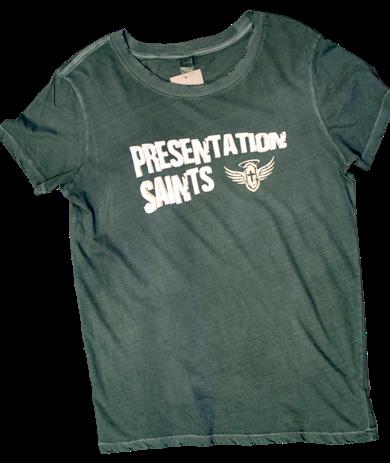
Arrow Boutique
Set of four Aberdeen landmarks coaster set
Dacotah Prairie Museum
Journey through the wild with a safari photicular book
Dacotah Prairie Museum
november/december 2018 ABERDEEN MAGAZINE 31
FATHER ROBERT HAIRE
HUMANITY’S FRIEND
THE WAY OF ABERDEEN’S RADICAL FIRST CATHOLIC PRIEST
by PATRICK GALLAGHER
It’s fitting that the main speaker at the dedication of the monument for Father Robert Haire on what is now Northern State University was named Firey. As J.H. Firey proclaimed, Father Haire “belonged to that class of men who are given to see the wrongs in existing things, political and economical, and his love of justice and fair dealing impelled him to lend his aid in correcting these wrongs…. He was fearless in attacking what he considered evil… Like many of the great reformers, far ahead of his time; measures and policies that he stood for then are paramount issues now.”
Within a week of arriving in Dakota Territory, on July 4, 1880, the proud American Haire quickly violated the separation of church and state. In Watertown to prove his claim on land near Columbia, where he would build the first Catholic church in Brown County, he exercised his twin passions for faith and country. On Independence Day, the priest said mass in the Watertown courthouse and then went outside and delivered a stirring patriotic speech from the building’s steps.

Thirty-five years later and a year before he died, an Aberdeen paper printed a sort of preeulogy of Father Haire, the first Catholic priest in Aberdeen and founding pastor of Sacred Heart Church: “A quarter of a century ago, Father Haire was one of the best loved and best hated men in the community, this because he was a pathfinder.” A century and a quarter later, that path has had an impact on a city, a state, and a nation.

FEATURE
32 ABERDEEN MAGAZINE november/december 2018
Born in Freedom, Michigan, in 1845, maybe it shouldn’t be surprising that he led the life he did. Raised by Irish Presbyterian parents, he converted to Catholicism after boarding with an Irish Catholic family while teaching school near Flint. After briefly practicing law, he entered the seminary and was ordained a priest in 1874. Eventually assigned to Flint, he soon led a group of pilgrims from among his parish to the promised land: Brown County, Dakota Territory. They arrived in Columbia on June 26, 1880. The next day, Father Haire said mass, the first recorded Christian service in Brown County.


Ever a booster for his adopted territory, Father Haire praised the “Jim River” area in a letter back to his Flint:
Everything [is] three times better than I expected it would be, and if anyone can raise five hundred dollars let him by all means come to Dakota… People talk about the cold and heat as extreme here. It is foolishness. [note: the date of the letter is July 5; he’d arrived 10 days earlier] … The air is delightful, as balmy as anyone could desire. The sun may burn you, but it does not boil you. The cold may bite you, but keep moving.
Interestingly, the letter also lays the groundwork for the radical way in which he would practice his faith: “…people are under the pressure of soulless corporations, but the good God has provided them with an earthly Eden to which to flee viz. the Valley of the Jim.”
Dakota Territory’s first bishop, Martin Marty, established a huge “parish” for Haire, which ran from the Missouri River to the Minnesota border and from roughly what became the North Dakota border to Huron.
He made his way on foot, horse, buggy, and train and celebrated mass in a variety of venues, ultimately helping to create parishes and build churches.
Headquartered in Aberdeen, Father Haire temporarily lived in the Sherman House Hotel, sometimes attracting 150 people to his Sunday masses there. Before long, and after the collapse of his sod church in Columbia, he decided to build a church in Aberdeen. He dedicated the new Sacred Heart Church in late 1882.
Around the same time, the Germanspeaking Haire helped German Benedictine nuns establish a convent in Zell in 1883. He visited often to offer mass for the sisters and local farmers. According to a Benedictine history, “After the services, while partaking of his scanty breakfast, he used to separate the few coins of the collection into three piles, one for the sisters, one for himself, one for such as were poorer than himself.”
In 1886, Father Haire decided Aberdeen needed a Catholic school, and beginning a long friendship, he invited the Sisters of the Presentation of the Blessed Virgin Mary to come from Fargo. After opening one inside the church, sisters and priest soon sought to construct a freestanding school.
Father Haire recruited members of the local Knights of Labor group to help build the school. While the Knights was an organization of mostly Catholic immigrant laborers, the Church forbade membership in it at the time. Thus Father
Haire was walking on thin ice, which could only have weakened as he took leadership roles in the state organization, including editing its newspaper.
As his politics were coming to the fore, so was the potential for conflict with his bishop. An advocate of temperance, Father Haire called for prohibition of alcoholic beverages, speaking around the state about it. While the bishop agreed in principle, he disagreed with his priest’s solution. The bishop might have been more irritated when Father Haire created Dakota’s first Catholic newspaper, the Dakota Catholic American, which inevitably became political. Bishop Marty stopped its publication after a few issues in 1888. Father Haire’s temperance stand, populism, support of women’s suffrage, and other causes couldn’t have pleased the bishop, but the priest was hardly finished. In 1888, he gave a lecture—somehow meant to benefit the construction of a local hospital—called “Reveille of the Revolution.” The Aberdeen News reported on the lecture. Father Haire “emphatically declar[ed] that the time had come when the laboring masses would have possession, and if this could not be secured in any other way a bloody rebellion would certainly be the result.” He also looked forward to a time when “the laws would be framed by the people themselves and not by a few pinheads and trading representatives of the Vanderbilt-Gould type.” The lecture foreshadowed a future direction.
Father Haire was ordained a priest as a young man in 1874. After briefly serving in Flint, Michigan, he and members of his parish moved to Brown County, Dakota Territory in 1880.
A monument dedicated to Father Haire was placed on what is now NSU’s campus.
november/december 2018 ABERDEEN MAGAZINE 33
Photo by Troy McQuillen
The path cleared when in 1889 Bishop Marty reassigned Father Haire to Wakonda. Haire refused, and the bishop dismissed him, not a full decade after he’d brought the Church to northeastern South Dakota. Though he remained a priest, he was stripped of his ability to administer the sacraments.
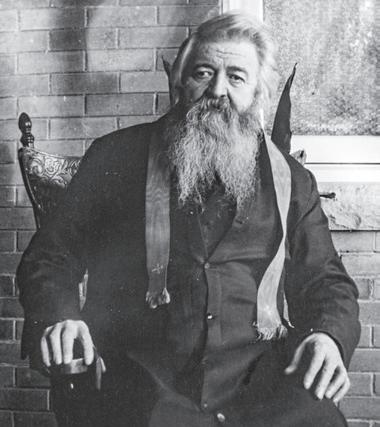

By this time, in addition to the Knights of Labor, Father Haire had also become involved with the Dakota Farmers Alliance, a national political organization. He helped create its political wing, the Independent Party, later the Populist Party, which advocated political reforms including the initiative and referendum. Having introduced the concepts as early as the mid-1880s, Father Haire is credited as being one of the originators of the American initiative and referendum. He believed in allowing citizens to propose laws directly, due to his distrust of the “plutes,” the plutocrats, whom he criticized in an 1891 issue of the Dakota Ruralist newspaper: “These men make the laws to suit themselves—are a law to themselves. The people seldom get any law passed they want.” Adding: “Of course, the entire plutocracy, given over to fleecing the values that labor produces, are afraid of the people.”
In 1898, when South Dakota’s only Populist governor, Andrew Lee, was reelected, the initiative and referendum were on the state ballot and were supported by all political parties. The measure passed by a wide margin, and South Dakota became the first in the nation to approve them. These tools of direct democracy have been adopted across the country and widely used, prompting numerous statehouse efforts to rein them in, a revenge of the plutes Father Haire might not have foreseen.
In 1897, Gov. Lee had appointed Father Haire to the state Board of Regents, a group the governor suspected of undermining his plans. Even an ally like Father Haire created headaches, however. Despite his boss’s belief the state needed no more institutions of higher learning, the Aberdeen booster Haire believed the Hub City needed a college. After Lee vetoed an attempt to create a “normal school” here, he accepted later legislation for a technology school.
Northern Normal and Industrial School opened in Aberdeen in 1901. The memorial to Father Haire on the campus of Northern State University reads:
“In Memoriam - Father Robert W. HaireHumanity’s Friend.” The rare recognition for a minister on a public campus was dedicated in 1924. One speaker at its dedication ceremonies said of the monument, “…standing as it does, in the very shadow of the buildings [Haire’s] imagination visualized years before they became a reality, it may bear witness to the young people of the possibility of accomplishment of a well-spent life.”
Disappointment with more mainstream political parties pushed Haire farther leftward. A newspaper reported on a speech in which he said, “Socialism was the only refuge [applause]…. He took occasion to announce himself as a socialist and his avowal was heartily applauded.” The father of the initiative and referendum also became one of the founders of the Socialist Party in South Dakota.
Nonetheless, Father Haire pursued a quieter path in Aberdeen. Or he did after he was a presidential elector for Socialist candidate Eugene Debs in 1900 and the 1902 Socialist nominee for the U.S. Senate. Otherwise, he kept a local focus as was noted in a posthumous tribute of the South Dakota Socialist Party: “During the
earlier years of the organization, he seldom missed a meeting, always taking a leading part, but gradually teaching us to think and speak for ourselves. Later on, he would take no part unless we seemed to be drifting from Marxian principles when he would set us right.”
The Marxist missed the minister, however. When Bishop Thomas O’Gorman replaced Bishop Marty, he consented to Haire’s request for reinstatement. The bishop gave him his final assignment in 1902 to serve as chaplain to the Presentation Sisters and their new St. Luke’s Hospital in Aberdeen.
On March 4, 1916, his road came to an end. He celebrated mass then retired to his room, where he became ill. Reportedly he called for a Socialist comrade who was also a local Baptist minister, but he arrived after Haire had died.
Among many tributes, Mr. Firey’s memorial dedication noted, “To him, could most fitly be given Christ’s commendation when he said, ‘I was hungered and ye gave me meat; I was thirsty and ye gave me drink; I was a stranger and ye took me in…”
Socialist leader Eugene Debs may have agreed, as he seemed to best summarize the map of Haire’s life: “Father Haire was a true follower of the Judean Carpenter. He gave all he had, and best of all, HE GAVE HIMSELF to the poor … But he not only sympathized with the poor, he told them WHY they were poor and how they might put an end to their poverty.” //
While Father Haire was strongly advocating for political reforms such as the initiative and referendum, he was dismissed by the bishop and stripped of his abilities to administer the sacraments. Later, he was reinstated and served as chaplain at St. Luke’s Hospital.
Photo by Troy McQuillen
Shown is Father Haire's sick call set, used when the priest would make "calls" or visits to the seriously ill to administer the Sacrament of the Anointing of the Sick.
34 ABERDEEN MAGAZINE november/december 2018
We would like to extend a special thank you to Kathleen Daly of the Presentation Sisters Archive for providing photos of Father Haire for this story.
THE ROMANCE OF WINTER

THE LOOK
photography by CHRISTINA SHILMAN OF PAISLEY TREE PHOTOGRAPHY
36 ABERDEEN MAGAZINE november/december 2018
www.facebook.com/AudrasDaySpa
Feast your eyes on an elegant wedding among the evergreens


Rain on your wedding day is a sign of good fortune, but so is snow. Christina Shilman of Paisley Tree Photography and Beadle Floral & Landscaping brought together the most beautiful elements of the season in this mock winter wedding celebration. All of the flowers, decor, props, and even hairstyles in these photos come from Aberdeen businesses. Married couple Kyle and Dakota Murphy stood in as our models for the day, getting dressed up again just one year after they tied the knot for real. //
 Hair and makeup styled by Audra Day Spa and Salon,
Flowers, greenery, and decor by Beadle Floral & Landscaping, www.beadlefloral.com.
Hair and makeup styled by Audra Day Spa and Salon,
Flowers, greenery, and decor by Beadle Floral & Landscaping, www.beadlefloral.com.
november/december 2018 ABERDEEN MAGAZINE 37
Flooring provided by Finishing Touch Design Studio, www.finishingtouchdesignstudio.com



rings from Heiser’s Jewelry, heisersjewelry.com Custom-made invitations and “To Have and To Hold” sign (previous page) designed by Pinned Workshop Aberdeen, pinnedworkshop.com
 Ivory/light champagne tulle wedding dress with beaded bodice complemented by a Micheal Kors tuxedo. Get this look at The Fuze, www.facebook.com/FuzeSD
Three-tier buttercream frosted cake with sugared cranberries by Sweet Pea Cakery, www.sweatpeacakerysd.com.
Ivory/light champagne tulle wedding dress with beaded bodice complemented by a Micheal Kors tuxedo. Get this look at The Fuze, www.facebook.com/FuzeSD
Three-tier buttercream frosted cake with sugared cranberries by Sweet Pea Cakery, www.sweatpeacakerysd.com.
38 ABERDEEN MAGAZINE november/december 2018
Wedding
THAT’S THE SOUND OF THE

MEN WORKING ON THE CHAIN GANG
(THEY DON’T MAKE A SOUND)
by PATRICK GALLAGHER
The unsung heroes of every football game are the most invisible people there: the chain gang. They track where the ball is on the field and where it needs to get for a first down. But you don’t notice them so much as what they hold. I tried to pay attention to them at some games, but my eyes kept going back to the field. As one gang member said, they’re supposed to be as inconspicuous as the referees (I laughed too).
At least five people run the chain gang. The “down” guy marks the spot of the ball for every play with a sign showing the current down. The chain team holds two sticks—one marking where the first down was for the current four downs, and the other, at the end of a ten-yard chain, marks the line to be gained for the next first down. The clip person attaches, well, a clip to the chain at a major yard line (one ending in 0 or 5), which helps the officials measure if a first down has been made as well as to put the chain back in the right place if the gang had to dodge an errant player. Finally, someone puts a target on the ground where the first down is, which is easier for everyone to see—plus it won’t move if the gang has to. The official crew typically works on the side of the field opposite the home team. Some chain gangs have a smaller unofficial crew on the other side.

The chain gangs for Aberdeen’s four football teams—Northern, Presentation, Central, and Roncalli—are made up
basically of volunteers, maybe with a little compensation. It’s the same at all levels of the sport: home team fans doing it to watch their favorite team up close, not for big bucks. NSU deputy athletic director Zach Flakus says the compensation “is a NSU cap and game tickets.” In addition to the swag, there’s a little swagger too.
NSU chain gang go-to guy Keith Schumacher is a Northern graduate, as are several team members. When they’re on duty, “We wear the NSIC conference approved vest,” he says, “with our maroon and gold underneath.” Keith joined in the early 1980s. “Jim Coughlin had been on the NSU chain gang for years,” Keith says.

“He kept inviting me to the gang’s pregame picnic and asked me to be a substitute. I did that a few times, then joined the next year.”
He’s still doing it because “I love football. There’s no better way to watch the game. It’s phenomenal to watch from that perspective.” His gang agrees: “We never have game days when we wake up not wanting to do it. There’s a lot of fun and
FEATURE
40 ABERDEEN MAGAZINE november/december 2018
camaraderie among our group.” They start the day with a tailgating picnic. “Jim Coughlin and Dennis Sahli started the pregame tailgater, which is always at someone’s home, not at the field. It’s always fun. Sometimes we have contests for the hottest sauce or horseradish, or we test varieties of brats.” Afterwards, they drive to the field together. “People see our camper pulling up and wave,” Keith says. “We have our own designated parking place.” Whatever celebrity they have, Keith and his gang do it to “return to the college what we got from the college.”

CHS and RHS have longstanding chain gangs too. In the mid-1980s, Ron Lyren’s neighbor was on Central’s chain gang. “They needed a sub one night, and he knew I’d do it,” Ron says. “I’ve been doing it pretty much ever since.” It took Brian Schumacher years to get the Roncalli gig. “It was always on the list of volunteer options for the Booster Club, and I always signed up, but there was never an opening,” he says. Then in 1999, Mark Gjernes was assembling a new chain gang, and he called Brian. About ten years later, Presentation asked Mark to do the same job for their new football program, so he called Brian again. There’s a lot of crossover with the Roncalli chain gang—maybe it’s a green and gold thing or a Catholic thing. Ron says. “I’ve always been around the game. I enjoy being on the line of scrimmage.” He’s also appreciated watching friends of his two daughters who graduated from Central play. For Keith, another perk is “seeing local high school players playing for colleges, seeing them mature. We also saw some future pros, like Vikings Adam Thielen, who played for Mankato, and C.J. Ham, from Augustana.”

The chain gang isn’t all serious. “We get to know the officiating crews,” Keith says, “and we know who we can give grief to. Some you can, and some you don’t.” While the NSU gang teases officials now and then, the Roncalli group pranks each other. “Sometimes when our guy would get down to set the clip,” Brian says, “the chain guys would move the chain to aggravate him. After that, we couldn’t get somebody to sub for the clip guy.”
 Members of the NSU chain gang are l to r: Mark Hanley, Mark Garvin, Kendell Titze, Keith Schumacher, Dale Smid, Jerry Cameron, and Tim Beck. Not pictured is Bill Pierce.
Photos by Troy McQuillen
Members of the NSU chain gang are l to r: Mark Hanley, Mark Garvin, Kendell Titze, Keith Schumacher, Dale Smid, Jerry Cameron, and Tim Beck. Not pictured is Bill Pierce.
Photos by Troy McQuillen
november/december 2018 ABERDEEN MAGAZINE 41
Keith Schumacher, Jerry Cameron, and Mark Garvin help manage the signal poles on the sidelines during NSU's home football games.
CHAIN GANG ROLL-CALL
While players, coaches, and officials get introduced at football games, the chain gangs usually go unmentioned. Here are the current core members of the chain gangs for each school in Aberdeen (not including substitutes):
Northern State University
Tim Beck
Jerry Cameron
Mark Hanly
Bill Pierce
Keith Schumacher
Dale Smid
Kendall Titze
Aberdeen Roncalli
Steve Everson
Corey Helms
John Kokales
Mike Kost
Mike Mattern
Brian Schumacher
Central High School
Roy Becker
Don Bonn
Geoff Durst
Paul Fauth
Brad Gardner
Gordon Kopecky
Ron Lyren
Mark Malchow
Presentation College
Steve Everson
Dan Grewe
Ryan Hansen
Corey Helms
John Kokales
Brian Schumacher
The elements add a challenge for guys who don’t usually get to do much running to keep warm. At old Swisher, Keith says, “Jim Coughlin and Dennis Sahli would build tents in the stands so their wives could be warm.” He remembers a Gypsy Day game that got called off because of lightning, “The rainwater was over the tops of our shoes, and we were holding metal sticks.” Brian remembers an early October Roncalli game with a 40 degree temperature and rain blowing horizontally in 30-40 mph winds. “Fortunately that game got mercy ruled at halftime,” he says.
One of the most unique memories belongs to Mark Gjernes. He was in Sisseton to watch his son play for Roncalli in 2006. The Sisseton chain gang was short one member, and they asked Mark if he would fill in. It had to be pretty unusual to work for the opponent—particularly in what turned out to be a blowout for the visitors.
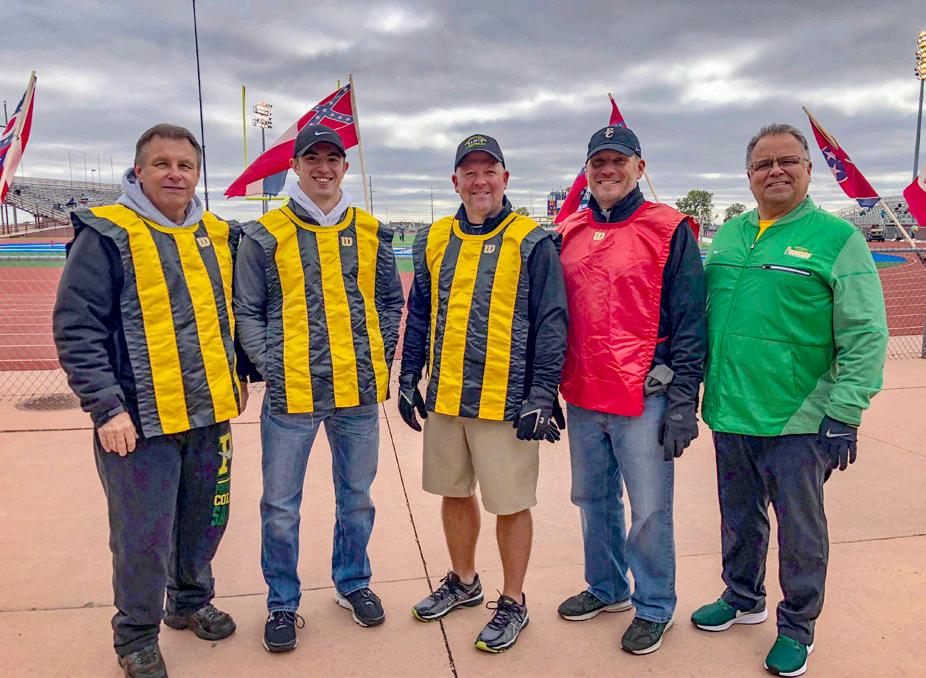
The chain gangs may not run the field as much as players and referees, but they get their turn. Keith says the two-minute drill is always exciting as the offense is trying to score in a hurry, and as the down marker guy, he has to keep up. “Officials would tell me to hurry up and get to position, because when I’m set, the play can start,” he says, “and the rest of the chain gang could catch up.” He adds, chagrined, “I used to be faster.” That’s a familiar story. Ron passed the down marker to his son-in-law a few
years ago after two knee replacements, and Mark’s knees made him give the job to Brian.
The basic job hasn’t changed much over the years, although Keith notes, “We used to be stationed right on the sideline, but now we’re a yard back. It’s safer for all concerned and also gives the refs room to run up and down the field.” They’ve also begun enforcing the rule that players and coaches have to be behind the chain gang. Before that change, Brian says, the Roncalli “sticks guys once tripped a coach. He got wrapped up in the chain while we were moving to the next position.”
There’s been talk about eliminating chain gangs in favor of something high tech and super-accurate, like laser or GPS. For now, though, the football gods think fans would miss the tradition and the drama of the chains coming out on the field after a fourth down conversion attempt, so no changes yet.
The chain gangs don’t change much, as Brian learned when he tried to get the job. Including the current group, Keith has worked only with about 11 guys over the 35 years he’s been doing it—an impressively small number for a team of seven and a testament to people who love what they’re doing. The NSU and CHS chain gangs each have over 100 years of combined service. Not many people would stay so long with a job no one knows they’re doing. //

42 ABERDEEN MAGAZINE november/december 2018
Members of the PC chain gang are l to r: Dan Grewe, Dan Gallagher, Steve Everson, Corey Helms, and Mark Gjernes. Photo by Andy Hansen
Area settlements that vanished
In this issue, we’ll look at the late-blooming towns in the Brown County area that sprang up along or near the growing railroad. All but a few have faded into history.

YESTERDAYS
44
by MIKE MCCAFFERTY photos provided by MIKE WIESE
➼ By the summer of 1881, the Chicago and Northwestern Railroad was moving into what is now Brown County. That same summer, the town of Ordway was platted. At this time the area was still known as Dakota Territory (both North and South Dakota), and the territorial governor was Nehemiah G. Ordway. The town was named after him for a good reason. The territorial capital had not yet been named, and because of its central location, Ordway became a candidate for the capital.
The town became a farming center, and because of the possibility of it becoming the capital, the Methodist Church decided to build a university there. It became a boom town and grew rapidly as settlers flocked to the area. In short order it had a general store, lumberyard, physician, two hotels, a lawyer, drug store, two elevators, and a blacksmith shop. Hopes were high and the future seemed bright.
In 1883 things changed rather drastically. By building on the rail line, Ordway was counting on becoming an economic hub. But when the railroad extended the line to Columbia, Ordway lost its economic advantage. In this same year, Bismarck was chosen as the territorial capital. On the heels of those two events, the construction of the Methodist university was abandoned, and in 1885 it was decided that the university would be built in Mitchell instead.
Ordway no longer exists. Hamlin Garland’s father operated the general store in Ordway and also farmed in the area. The road between Highway 281 and the city of Columbia is named after him.
Huffton
➼ In 1882, settlers from Michigan moved into what is now Brown County and founded this settlement in anticipation of the Milwaukee Railroad coming through from Groton. It was originally named Foxton. A post office was established on October 24, 1882. Foxton continued to slowly grow, and in 1889 the town was moved to the David Huff homestead and renamed Huffton.
At the peak of its growth, the town had two elevators, a post office, general store, school, church, and several residences. Over the years the church steeple was removed as the congregation consolidated with another church, and the building became the town hall until it was eventually torn down. In the 1960s, the two elevators were sold to area farmers for storage, and Huffton drifted off into history.
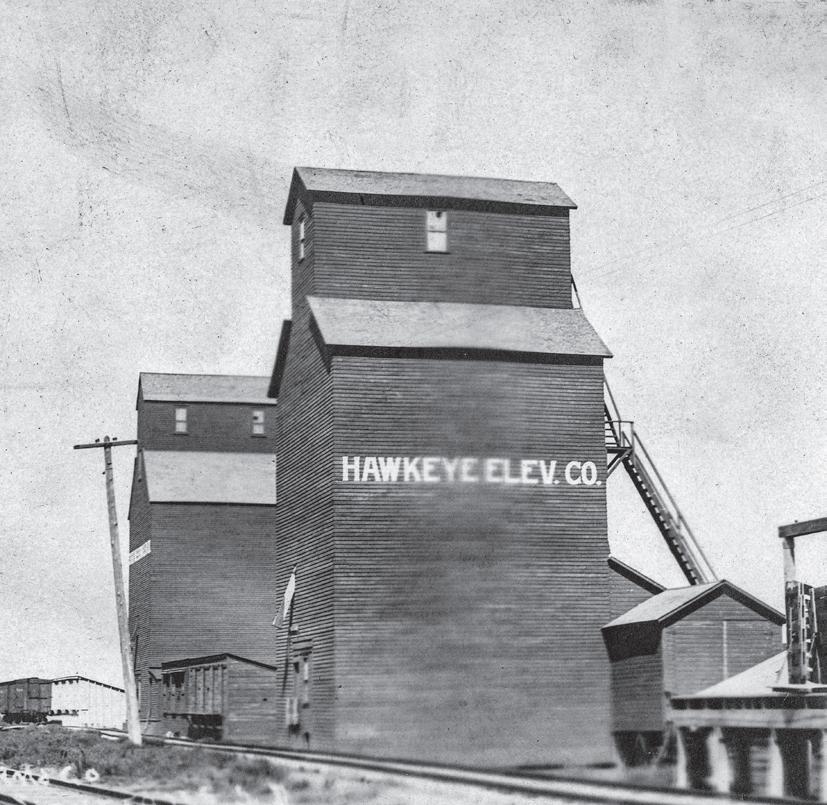
Detroit
➼ Detroit was established in 1883 after a post office was commissioned on April 24 of that same year. The developers of Detroit were betting on a rail line coming through from Groton. The town grew very fast. A general store and a one-story hotel that contained offices, a dining hall, and rooms in the back were built. Shortly thereafter, lumber was obtained from Columbia and a church was built and named Father Hedger Methodist Church, honoring him as the father of his two sons who were promoting the town along with others. The official plat of this town was not officially filed until May 8, 1884. As soon as this was completed, a town hall, school, blacksmith shop, and drug store were established. The town began publishing a newspaper, the Detroit Free
Randolph
Press, which was printed in Columbia. As the town grew, the only way to get to Detroit was a prairie road that followed the stakes for the proposed rail line from Groton. As fast as this town was growing, its demise was even faster.
In 1886, the St. Paul-MinneapolisManitoba Railroad built a line from present-day North Dakota to Aberdeen seven miles southeast of Detroit where the town of Claremont was platted. In addition, as the Chicago and Northwestern Rail Line expanded, the town of Hecla was established. With no rail line and no road access, the town dissolved and buildings moved. The general store was moved to Claremont, the church moved two miles north of Claremont, and the blacksmith shop, hotel, and dance hall were all moved to area farms. Detroit was gone as quickly as it came.
➼ Randolph was platted along the Minneapolis and St. Louis Rail Line in the southern part of the county in 1908. The town served a large area before road and highway improvements allowed people to travel easily. During its heyday, Randolph had a general store, bank, hardware store, church, school, post office, barbershop, and five elevators. The town, like all small towns, declined greatly during the Dirty Thirties. The post office and general store operated until 1953.
1910
Ordway
45
Putney
➼ The hard times of 1883-1886 took a toll on early settlements due to poor crops and drought. By the end of 1886, things were looking better due to improved harvests, so the railroads continued their expansion. The Chicago and Northwestern Railroad extended their lines, and the construction of the incoming Great Northern and Minneapolis and St. Louis Lines reinvigorated the establishment of towns.
In 1887, the town of Putney was platted along the rail line. The settlers were from New England and named the town
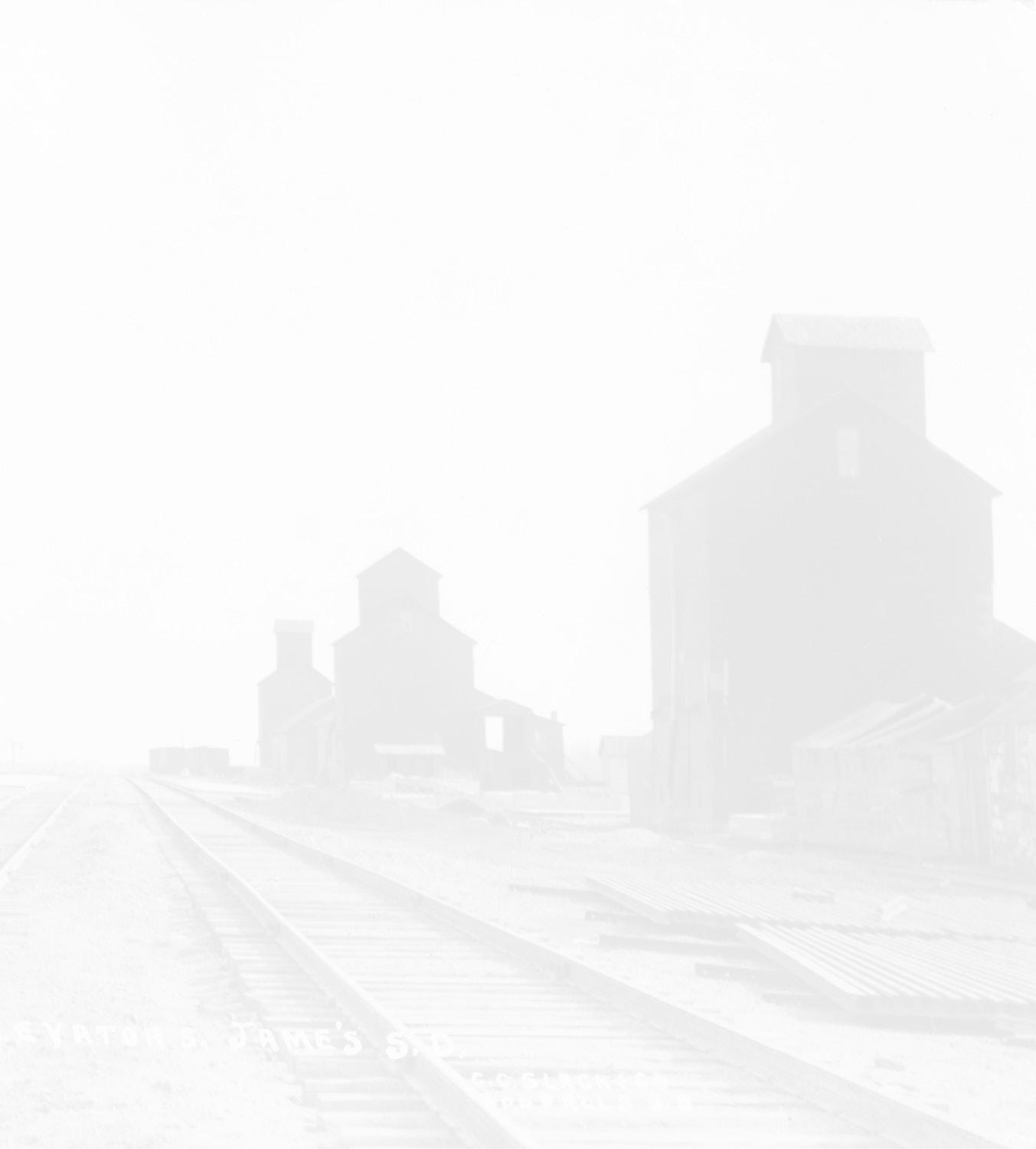
James
➼ James was originally named Chedi after the lake that had been constructed on the James River near Columbia. In January 1889, a post office was commissioned. A depot was built at that same time, along with a lumberyard, hotel, café, church, parochial school, poolroom, general store, jail, three elevators, and several homes. In March 1896, the town name was changed to James in honor of F.D. James, who owned the southeast quarter being subdivided for the town. F.D. James was the brother of Tom James, who settled in the Tacoma Park area.
In the early days, James was wellknown due to its saloon, since Aberdeen and Groton were both “dry.”
Plana
➼ Welsh settlers from Wisconsin established Plana in 1887. It was originally named Hadley, but was then changed to Plana. A post office was commissioned in August 1887. Soon a train depot was built, followed by a school, church, community hall, barber shop, general store, three elevators, and several homes. Since its establishment, the town has disappeared.
Fife
after Putney, Vermont. Rather quickly, a hotel, two grocery stores, a general store, blacksmith shop, drug store, and dance hall were all open for business. For a few months in 1887, they published a paper called The Putney Messenger. Shortly after 1900, a service station and two elevators were built. Over the years the town dispersed, although a general store did operate until the 1970s. The dance hall was purchased by John Sieh and moved to the Granary Rural Cultural Center, where it has been restored and is used for events held by the Dacotah Prairie Museum.
➼ Fife was located seven miles west of Aberdeen along the Milwaukee Road Rail Line on a side track on the Yoder farmstead. J.G. Brady built an elevator capable of handling 25,000 bushels of grain at a time. The elevator operated under Brady until 1927, when it was bought by Wheat Growers. J.W. Ziegler, a well-known elevator man and farmer from the Fife area, would manage it. Difficult financial times led to the closing of the Fife elevator.
People flocked from miles around to enjoy a touch of spirits. In fact, they sold their own brand of liquor that was labeled “Bottled for the Ladner Bros., James, SD., 1897.” Because of this, the saloon drew a fair number of rambunctious transients. After becoming intoxicated and rowdy, they were jailed in the town jail. However, the jail doors were “magically” opened prior to when the next scheduled freight train was due. It solved the problem.

The general store operated until it burned down in 1927. It was not rebuilt because by that time the town’s population had dropped to 10. Today, there are just a few homes left in James.

46 ABERDEEN MAGAZINE november/december 2018
1916
➼ Stratford was platted in October 1906 along the last rail line to be built, the Minneapolis and St. Louis. Founders wanted to name it Rondell after the first early settlement in the area, but the railroad chose Stratford. Within weeks of it being platted, the town sprang up. Lumber and supplies for construction were hauled in from Aberdeen and Ferney. The first building up was the Stratford Mercantile Company.
It took two years for the railroad to finally reach Stratford in 1908, but when it did there were four elevators almost full of grain waiting for shipment. That same year, passenger trains were taking people from Stratford to Watertown and back for $2.15 per trip. Two trains were running daily through Aberdeen, carrying up to one 100 passengers every day.

By 1909 there were two banks, three restaurants, two dray and transfer companies, two blacksmith shops, two hardware and harness dealers, two physicians, a drug store, newspaper, poolroom, barber and bath, furniture store, farm implement dealership, confectionery, flour and feed mill, shoe store, insurance agency, real estate office, lumberyard, meat market, and a milliner’s shop. By 1911, it
Stratford Richmond
reached its peak population of 600. Also in 1911, an artesian well began furnishing the residents with water, with water lines put in shortly thereafter. A cement factory was started and operated into the late 1920s. Pete The Butcher had the second walk-in cooler in the state, managed a smokehouse, and became famous for his homemade sausage, ham,
and liverwurst. He hauled wagon loads of meat to Aberdeen on a regular basis. He also won a national carcass skinning contest in Chicago hosted by Swift & Company. Fires during the early 1920s, the stock market crash in 1929, and severe drought conditions caused by the Dirty Thirties all took a toll on the town. Today, Stratford is still going as a nice small, quiet community.
Rudolph
➼ Richmond was platted along the Minneapolis and St. Louis Rail Line northwest of Aberdeen on March 19, 1907. A depot, grain elevator, stockyard, lumberyard, store, and house for a freight agent were built. A post office opened in April 1909. By 1909, there were 144 residents. In 1913, the post office moved to Wetonka, and in 1926, the depot moved to Long Lake. The Dirty Thirties ended the town, although a grain elevator did operate until 1967. It was located by what is Richmond Lake today.
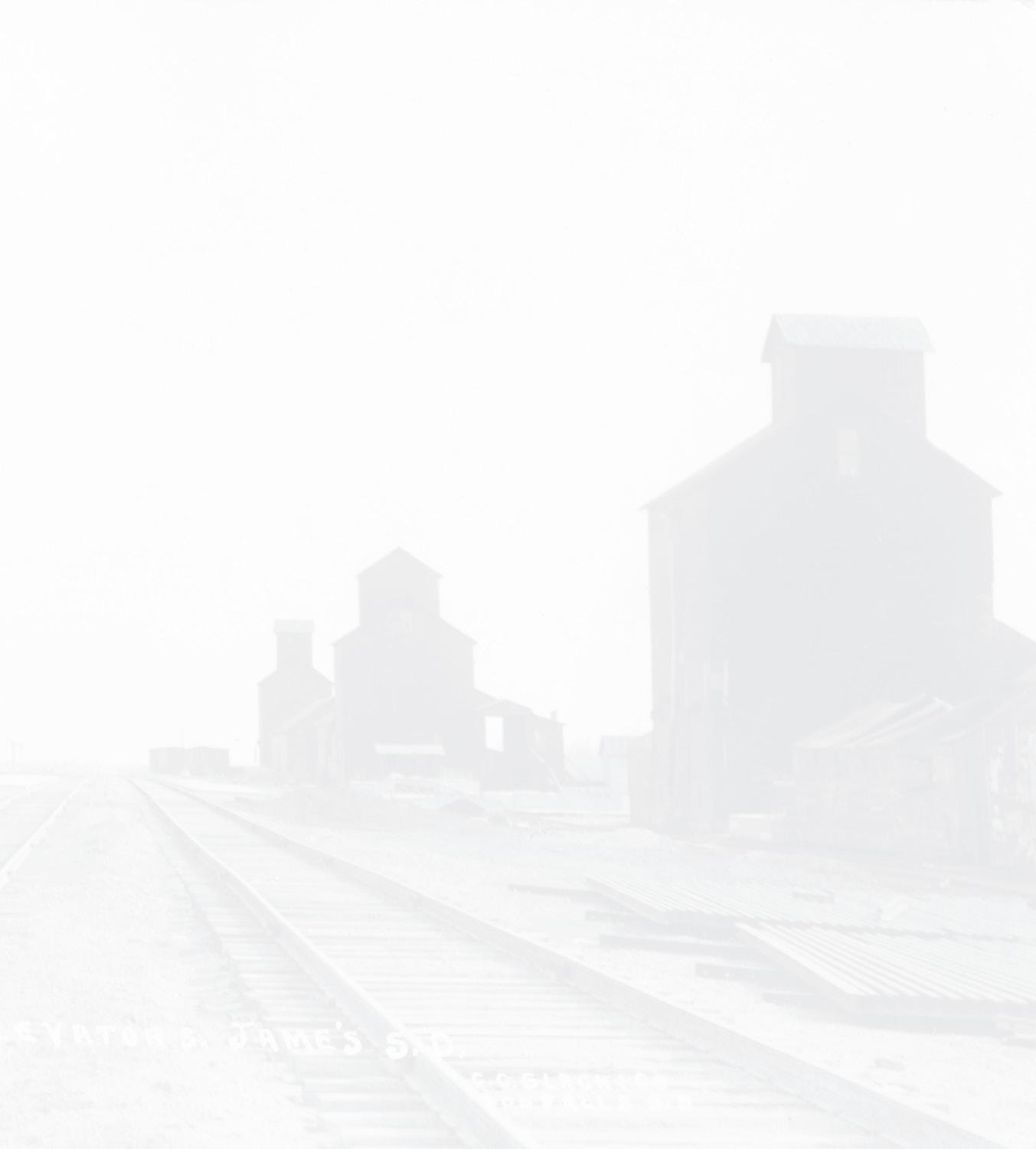
Barnard
➼ Barnard was the last town to have a post office commissioned in 1910. In 1911, the town was platted. In 1915, the population was only 18, but the town already had a general store, bank, lawyer, feed mill, grain dealership, and blacksmith. By 1920, the population increased to 50 and stayed there until 1925. During this five-year period, land prices were climbing and crop prices were good. The drought of 1926, along with the stock market crash of 1929 and the Dirty Thirties, spelled disaster for this bonded community. A few people still call this Barnard home.
➼ Rudolph was platted on November 18, 1881, but few settlers came. At the time, like Ordway, it was established along the Chicago and Northwestern Rail Line. On April 3, 1883, the site became a post office. John Morrow put the site on a section of land where he was operating a livestock business. Once the railroad built a depot, Morrow constructed a huge building near it that served as his home and contained a general store, post office, meat market, and hotel. He also operated a livery barn and established a stockyard for the shipping of cattle by rail until 1908. The huge appeal of the rapidly growing towns of Aberdeen and Warner led to the quick demise of Rudolph. //
48 ABERDEEN MAGAZINE november/december 2018





























 by JENNY ROTH
by JENNY ROTH






 by JENNY ROTH
by JENNY ROTH












 In Mahto to Wakpala Betty painted a landscape from a side road north of Highway 12 on the Standing Rock Reservation.
In Mahto to Wakpala Betty painted a landscape from a side road north of Highway 12 on the Standing Rock Reservation.

 JENNY ROTH
JENNY ROTH












 by JENNY ROTH
by JENNY ROTH





 Big Fella’s earns its name, serving dishes large enough for the heartiest of appetites.
The steaks at Big Fella’s are hand cut in house.
Big Fella’s earns its name, serving dishes large enough for the heartiest of appetites.
The steaks at Big Fella’s are hand cut in house.











 Fulton & Roark long-lasting men’s cologne and personal care set, with men’s dress socks Karisma Boutique
A trio of signature wing sauce flavors Circus Sports Bar and Grill
Fill a growler with his favorite beer Pounders Pub & Grub
Rebekah Scott bags, designed and sewn in South Dakota The Farmer's Wife Boutique
Fulton & Roark long-lasting men’s cologne and personal care set, with men’s dress socks Karisma Boutique
A trio of signature wing sauce flavors Circus Sports Bar and Grill
Fill a growler with his favorite beer Pounders Pub & Grub
Rebekah Scott bags, designed and sewn in South Dakota The Farmer's Wife Boutique

























 Hair and makeup styled by Audra Day Spa and Salon,
Flowers, greenery, and decor by Beadle Floral & Landscaping, www.beadlefloral.com.
Hair and makeup styled by Audra Day Spa and Salon,
Flowers, greenery, and decor by Beadle Floral & Landscaping, www.beadlefloral.com.



 Ivory/light champagne tulle wedding dress with beaded bodice complemented by a Micheal Kors tuxedo. Get this look at The Fuze, www.facebook.com/FuzeSD
Three-tier buttercream frosted cake with sugared cranberries by Sweet Pea Cakery, www.sweatpeacakerysd.com.
Ivory/light champagne tulle wedding dress with beaded bodice complemented by a Micheal Kors tuxedo. Get this look at The Fuze, www.facebook.com/FuzeSD
Three-tier buttercream frosted cake with sugared cranberries by Sweet Pea Cakery, www.sweatpeacakerysd.com.





 Members of the NSU chain gang are l to r: Mark Hanley, Mark Garvin, Kendell Titze, Keith Schumacher, Dale Smid, Jerry Cameron, and Tim Beck. Not pictured is Bill Pierce.
Photos by Troy McQuillen
Members of the NSU chain gang are l to r: Mark Hanley, Mark Garvin, Kendell Titze, Keith Schumacher, Dale Smid, Jerry Cameron, and Tim Beck. Not pictured is Bill Pierce.
Photos by Troy McQuillen








